This is the website of Abulsme Noibatno Itramne (also known as Sam Minter).
Posts here are rare these days. For current stuff, follow me on Mastodon
|
Yeah, yeah, primaries. Another general election poll, this time in Pennsylvania. They polled a bunch of different candidate combinations, but the one with a significant change was Clinton vs Trump:
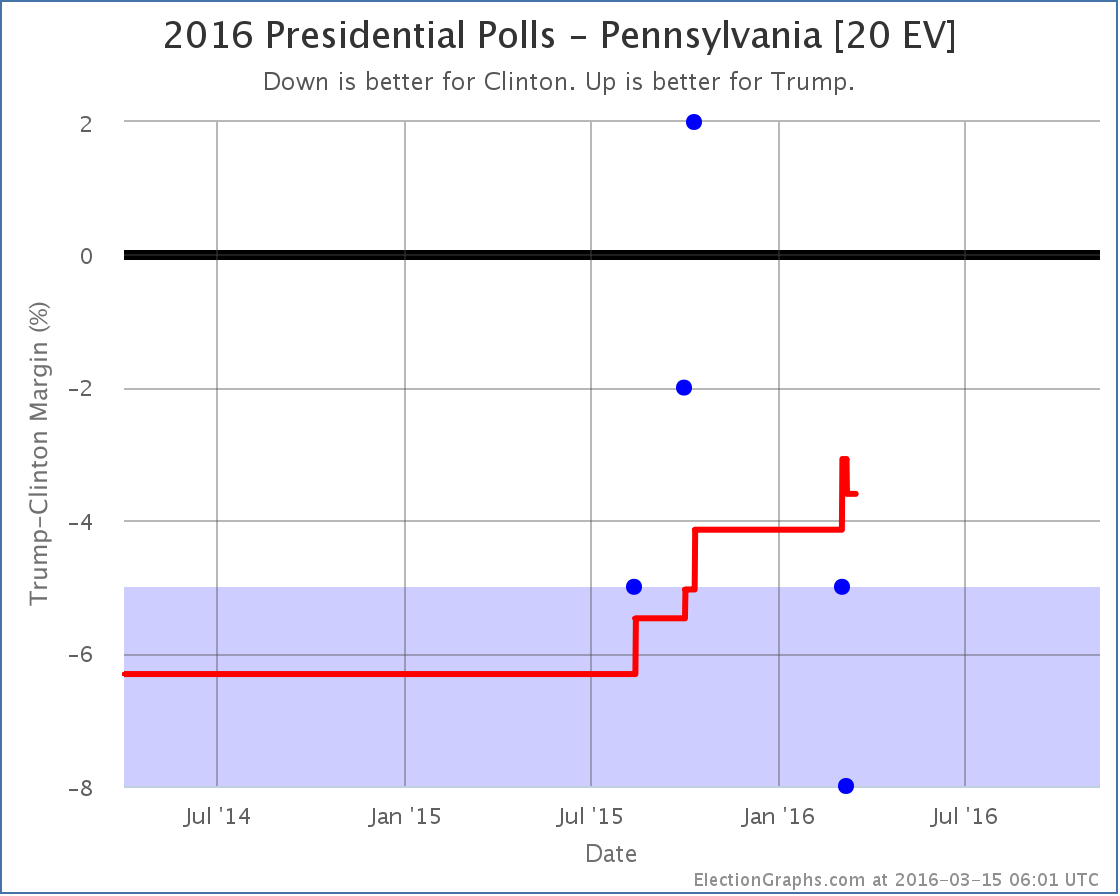
No category change. Pennsylvania stays “Weak Clinton”. But Pennsylvania was the tipping point state in Clinton vs Trump, so when Pennsylvania moves, so does the tipping point:
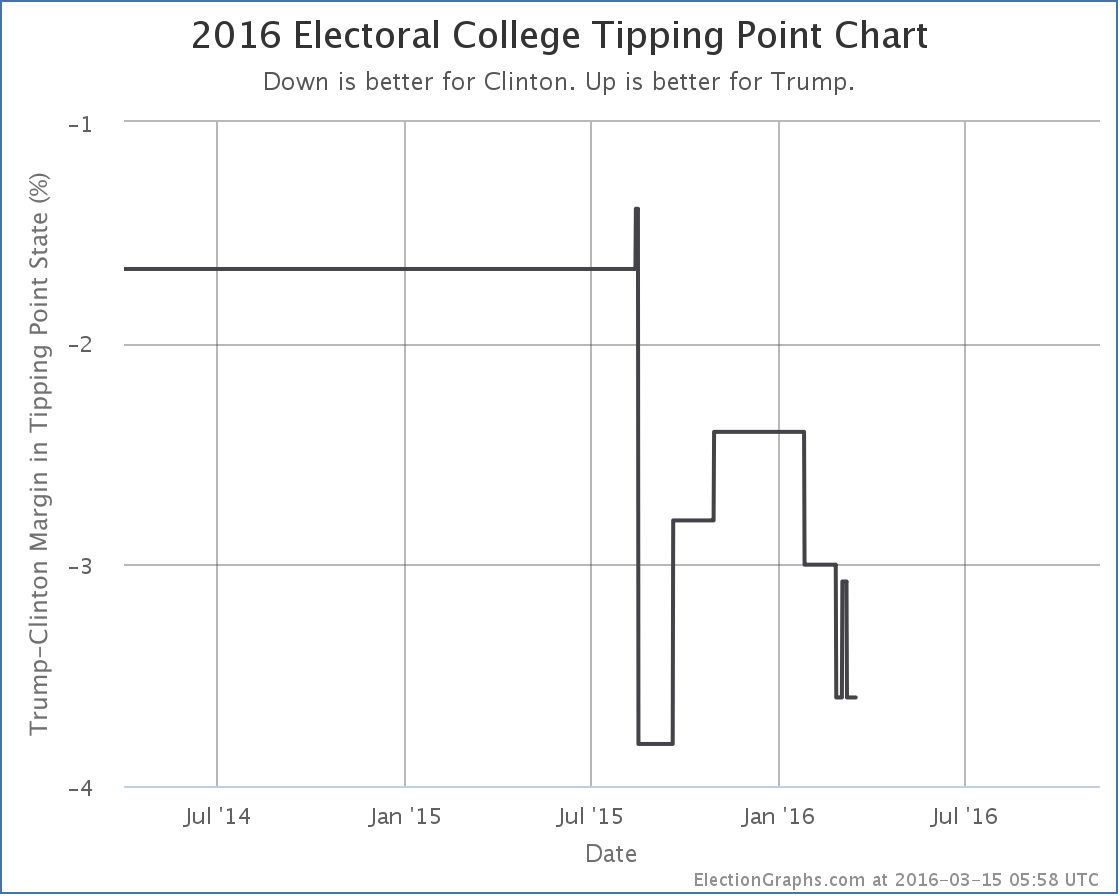
The tipping point goes from Clinton by 3.1% in Pennsylvania, to Clinton by 3.6% in Pennsylvania… which happens to be the same as it was just a few days earlier. So things just bouncing around a little bit. The trend since January on the tipping point seems to be away from Trump and toward Clinton… but there is lots of time yet.
238.0 days until the polls start closing on election day.
Note: This post is an update based on the data on ElectionGraphs.com. Election Graphs tracks both a poll based estimate of the Electoral College and a numbers based look at the Delegate Races. All of the charts and graphs seen in this post are from that site. Additional graphs, charts and raw data can be found there. All charts above are clickable to go to the current version of the detail page the chart is from, which may contain more up to date information than the snapshots on this page, which were current as of the time of this post. Follow @ElectionGraphs on Twitter or like Election Graphs on Facebook to see announcements of updates or to join the conversation. For those interested in individual general election poll updates, follow @ElecCollPolls on Twitter for all the polls as they are added.
As I mentioned yesterday, Christie is seemingly still in the Republican race. There hadn’t been any state level polls that included him since August, but then yesterday there was one in Virginia that improved his position against Clinton. And now in today’s update we have another poll that included him, this time PPP in Pennsylvania, and once again the result is an improvement in Christie’s position vs Clinton.
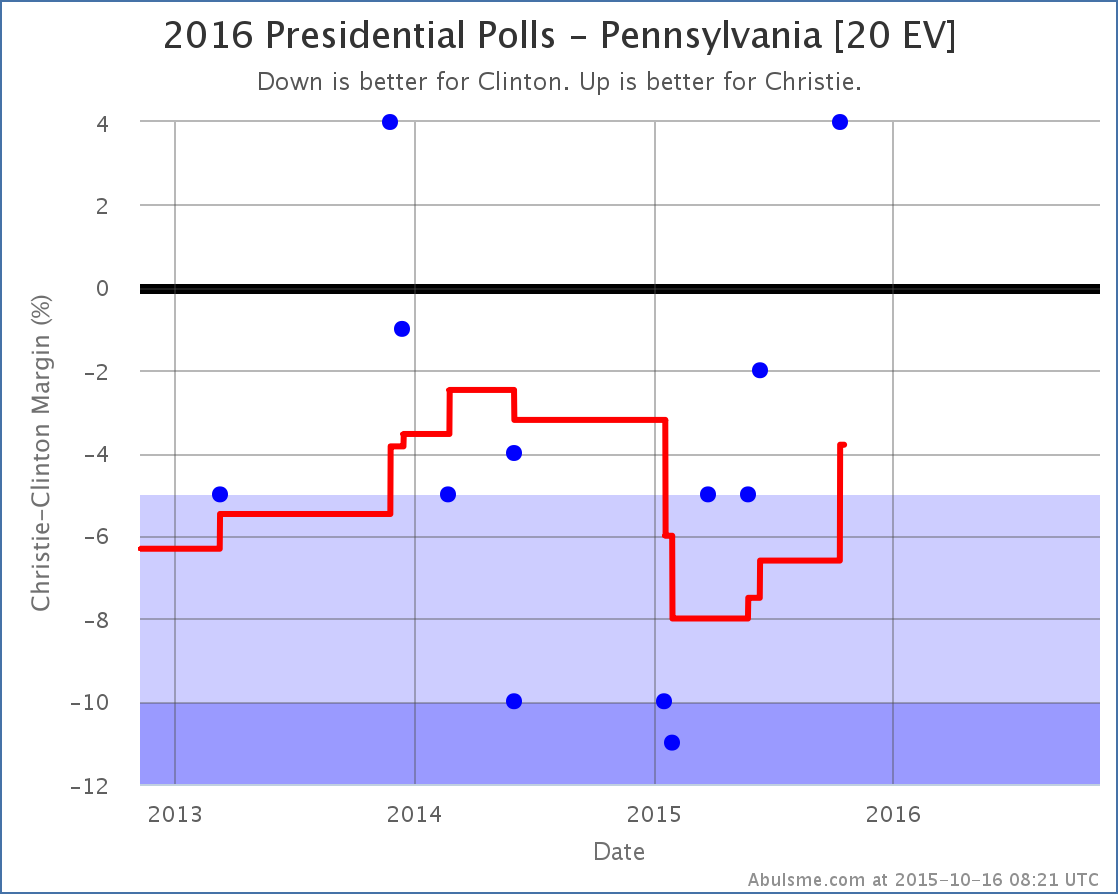
This makes Pennsylvania a possible pickup for Christie and thus improves his “best case” scenario even further.
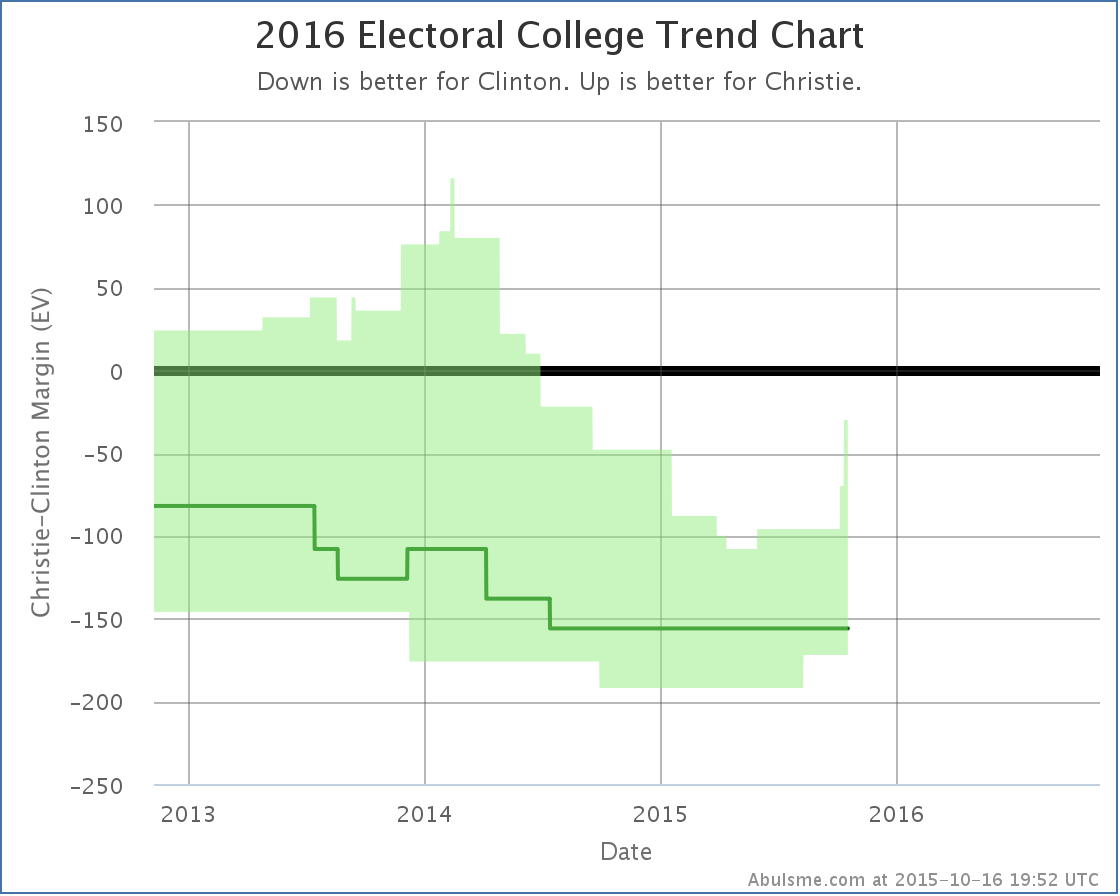
I snarked yesterday about how Christie’s best case was to lose by 70 electoral votes. Well, now his best case is to lose by 30 electoral votes. So he actually is getting a lot closer to being in reach. Of course I also made fun of his 1.9% in the RCP average of national Republican polls… oops, it is 1.7% now.
Clinton vs Christie is still the 5th “best polled” candidate combination according to the metric I use, but I expect that will probably change before too long as we continue to get more and more polls including Trump, Carson, Fiorina and Cruz, with fewer including Christie. Not to mention more with Sanders and Biden. They all seem to have gotten more polling action lately, but not yet enough to bring them into the “top five” I talk about here. There are still significant gaps in close state polling for those candidates, but those are gradually being filled in.
To briefly illustrate why I don’t talk about all the candidate combinations here, the new polling in Pennsylvania from PPP yesterday actually resulted in all of these changes:
Those are all tweets from @ElecCollPolls. That account tweets each and every electoral college related change on ElectionGraphs.com, including each individual poll result as it is added. If you are interested in that level of detail, follow @ElecCollPolls on Twitter.
But be careful interpreting what you see beyond the five best polled combinations I highlight here. There is often still very sparse polling, certainly when compared with the top five, and the averages still rely quite a lot on previous general election results, so it may or may not yet be giving a good picture of where things really stand for that candidate pair. You can still get some insight of course, you just have to be careful.
Here on the blog, I concentrate on the candidate pairs with the most robust polling, and on the changes that impact the range of possible results for those candidates. These “top five” candidate pairs are really where the amount of data available is best and where I can feel the most confident drawing conclusions from the data… and even then you sometimes have to be careful reading too much into things.
After all, it is still 389.1 days until polls start to close. Things will change a lot in those days. Which is why tracking this is fun. Keep watching.
Note: This post is an update based on the data on ElectionGraphs.com. All of the charts and graphs seen here are from that site. Graphs, charts and raw data can be found there for the race nationally and in each state for every candidate combination that has been polled at the state level. In addition, comparisons of the best polled candidate combinations both nationally and each in each state are available. All charts above are clickable to go to the current version of the detail page the chart is from, which may contain more up to date information than the snapshots on this page, which were current as of the time of this post. Follow @ElecCollPolls on Twitter for specific poll details as I add them. And like Election Graphs on Facebook!
This is probably the most significant update I’ve posted since launching this analysis in November. For the first time, one of the Republicans with significant amounts of polling is actually leading Clinton. Specifically, in Clinton vs Rubio, the “expected result” where each candidate wins all the states where they currently lead in my polling average, is now Clinton 268 to Rubio 270. That is a narrow win, but that is a win.
Since the spring, almost every update has been bad news for Clinton, but the collapse here has been more rapid than that. As recently as July, Clinton was leading Rubio by 156 electoral votes in my analysis. In less than three months, this lead completely evaporated. It is a long way until the election still. And some deterioration was expected. But this trend for Clinton is dramatic. Has she reached the bottom yet? Absent additional major negative revelations, she must be close to a floor… but there is no slowing of this trend visible yet. Things just get worse and worse for Clinton. (At least vs Rubio and Bush… for other opponents, either the trend is less dramatic, or there is just not enough recent state level polling data to draw good conclusions yet.)
Clinton vs Rubio
Lets look into the details. First of all, Pennsylvania:
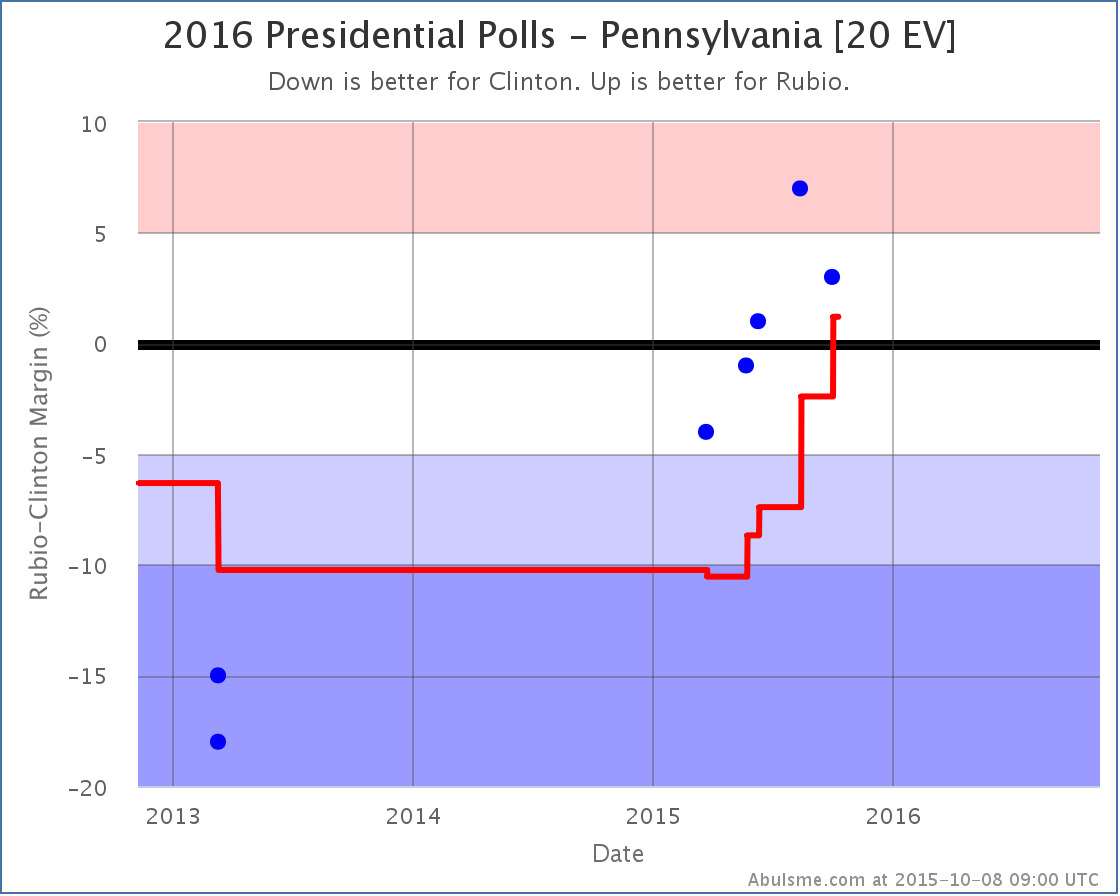
Pennsylvania has not been as heavily polled as some other states, the poll average still covers 6.6 months, but the trend here resembles the trend in many other states, with Clinton losing ground with almost every poll. With this last poll, the average was pulled over to Rubio’s side of the center line. Pennsylvania’s 20 electoral votes was enough to make Rubio the overall winner. This was the big change that caused today’s headline.
Between Pennsylvania’s move, and a smaller move in Ohio that didn’t cross category lines, the tipping point of course moved too:
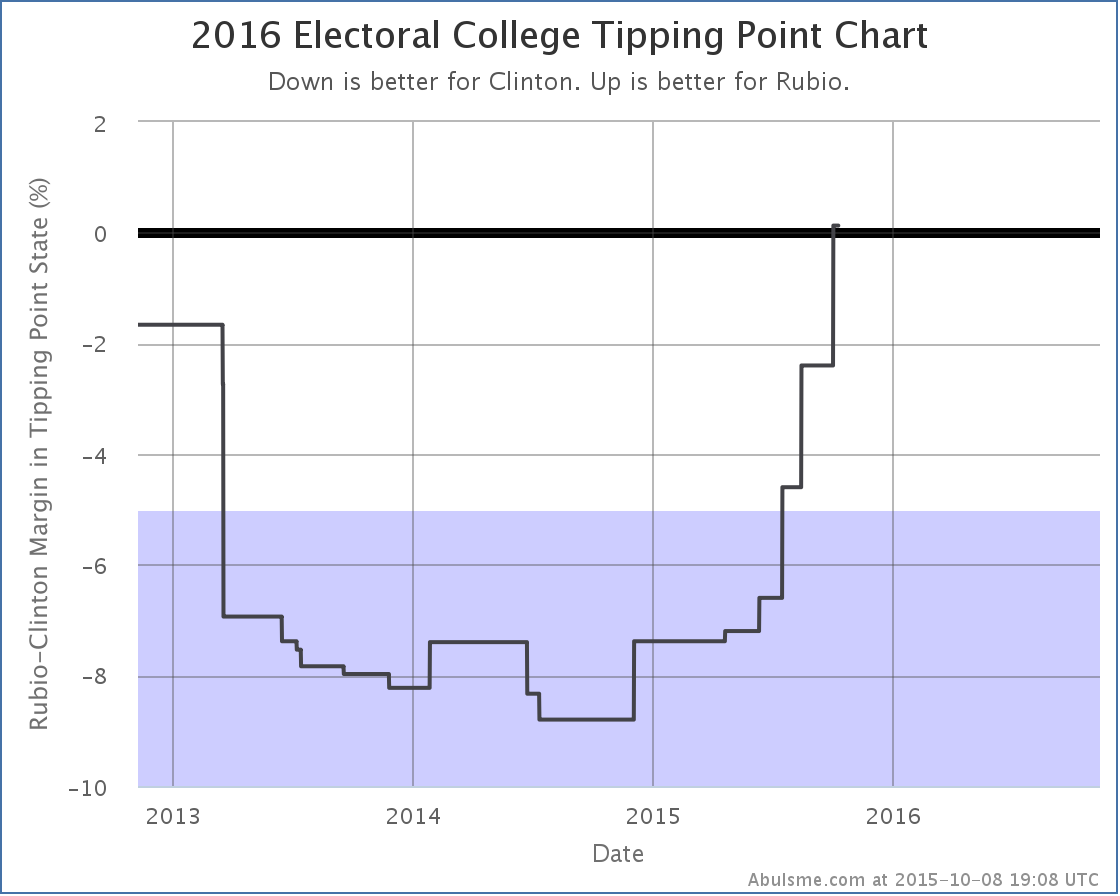
A year ago the tipping point was at 8.8% in Clinton’s favor. It is now Rubio by 0.1%. That is a razor thin margin, but it is a Rubio win.
Which brings us to the fact that there actually was one positive thing for Clinton in the latest Clinton vs Rubio results. Florida.
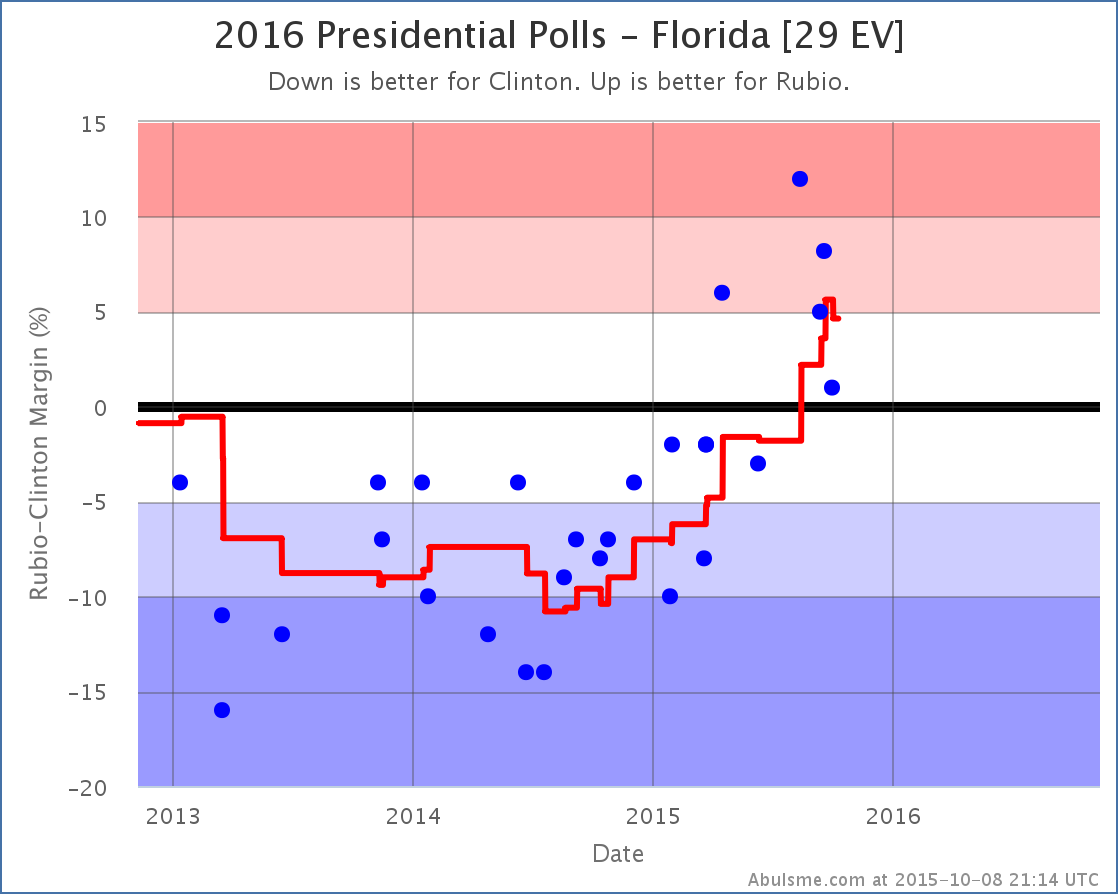
The poll average in Florida actually moves a little toward Clinton with the latest poll, bringing it to a 4.6% Rubio lead. This once again puts Florida in the “could go either way” category based on my classifications, and so improves Clinton’s best case.
With all of these changes, here is the new “bubble”:
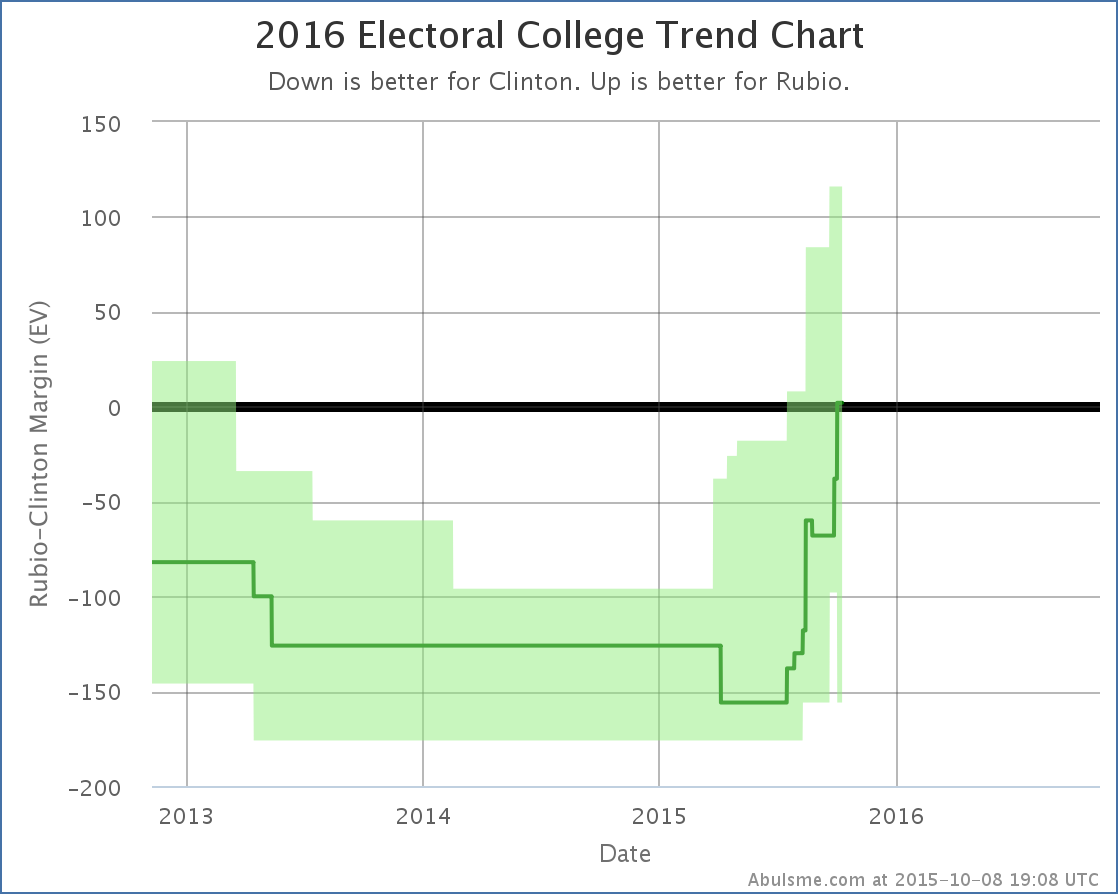
One of the most surprising things about this chart, especially compared to how things looked a year ago, is just the height of that bubble… the range of possible outcomes that are reasonable given the current state of polling. Right now the summary looks like this:
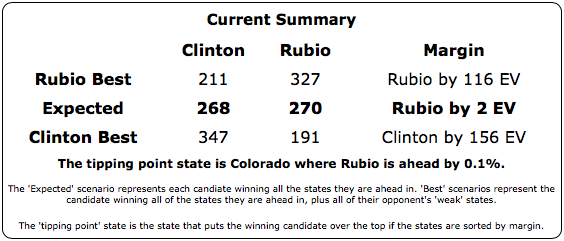
And the state spectrum:

There are now TEN states where the polling is close. 136 electoral votes. Everything from Clinton winning by 156 to Rubio winning by 116 is plausible given only minor moves in the polls. This is a huge range of possible outcomes here.
Right now, the tipping point is right smack in the middle of those states, five on each side of the line… with a margin in the tipping point state of only 0.1% and Rubio ahead by only TWO electoral votes. The only way this could be closer is if we were actually looking at a 269-269 tie.
Right now, 13 months from the election, Clinton vs Rubio is as close to an even race as you could possibly imagine. But with the huge number of close states, it is “close” in the sense of too close to call, but we can’t rule out the possibilities of either candidate winning by a significant margin! There are just too many states that could go either way. (Having said that, results closer to the middle of the range are indeed more likely than those at the edges. Having ALL the close states go to one candidate or the other is extremely unlikely.)
A lot can and will happen in the next year… it is certainly possible that neither of these two candidates end up as the nominees. But this can’t be where Clinton hoped to be at this point. She wanted to be seen as not just inevitable for the Democratic nomination, but with a very healthy lead in the general election.
That is not what is happening.
The question now is if Rubio is able to start strengthening this into a clear lead, instead of just a toss up. Can he start flipping Ohio? New Hampshire? Michigan? If current trends continue, it would not be surprising…
Clinton vs Bush
Although the big news was in Clinton vs Rubio, there was also a change in Clinton vs Bush. It also favored the Republican.
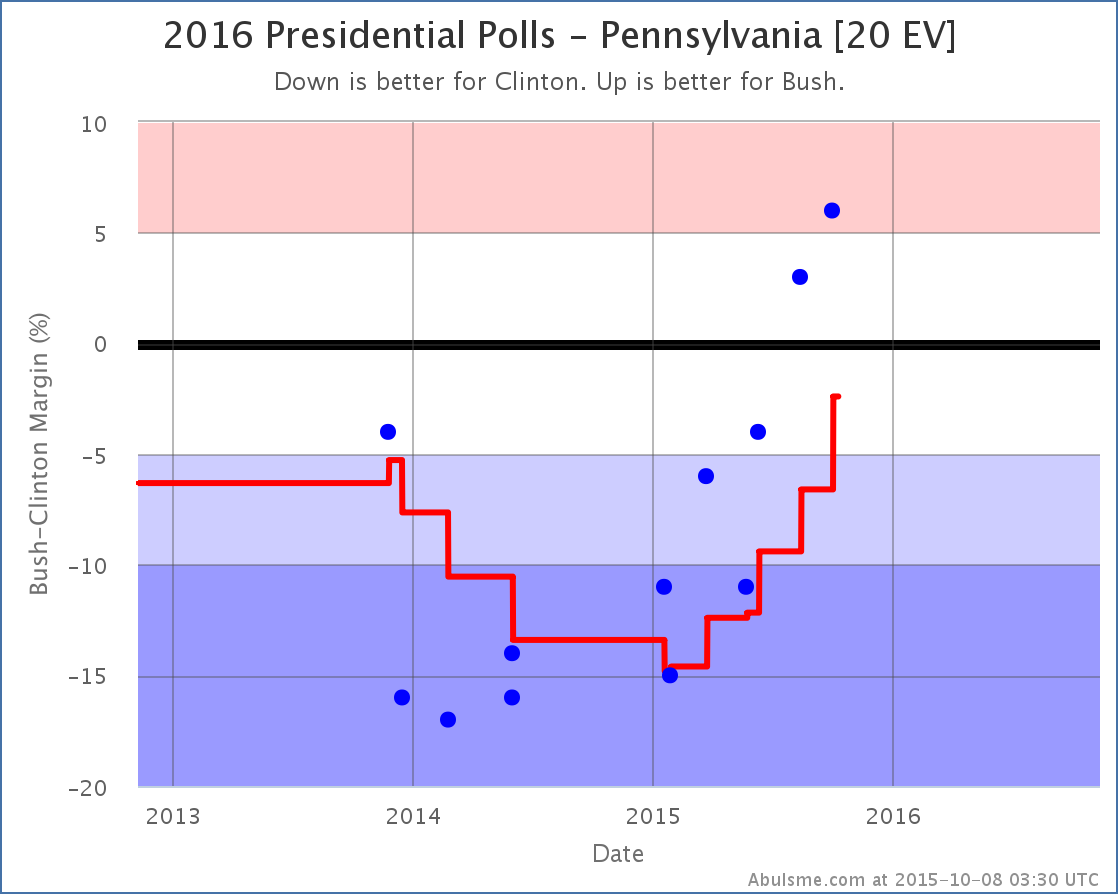
Bush is a bit behind Rubio in his Pennsylvania polling against Clinton, but it has also been consistently improving for months. With today’s new poll, Clinton’s lead drops to 2.4%, putting Pennsylvania in the swing state category, and improving Bush’s best case.
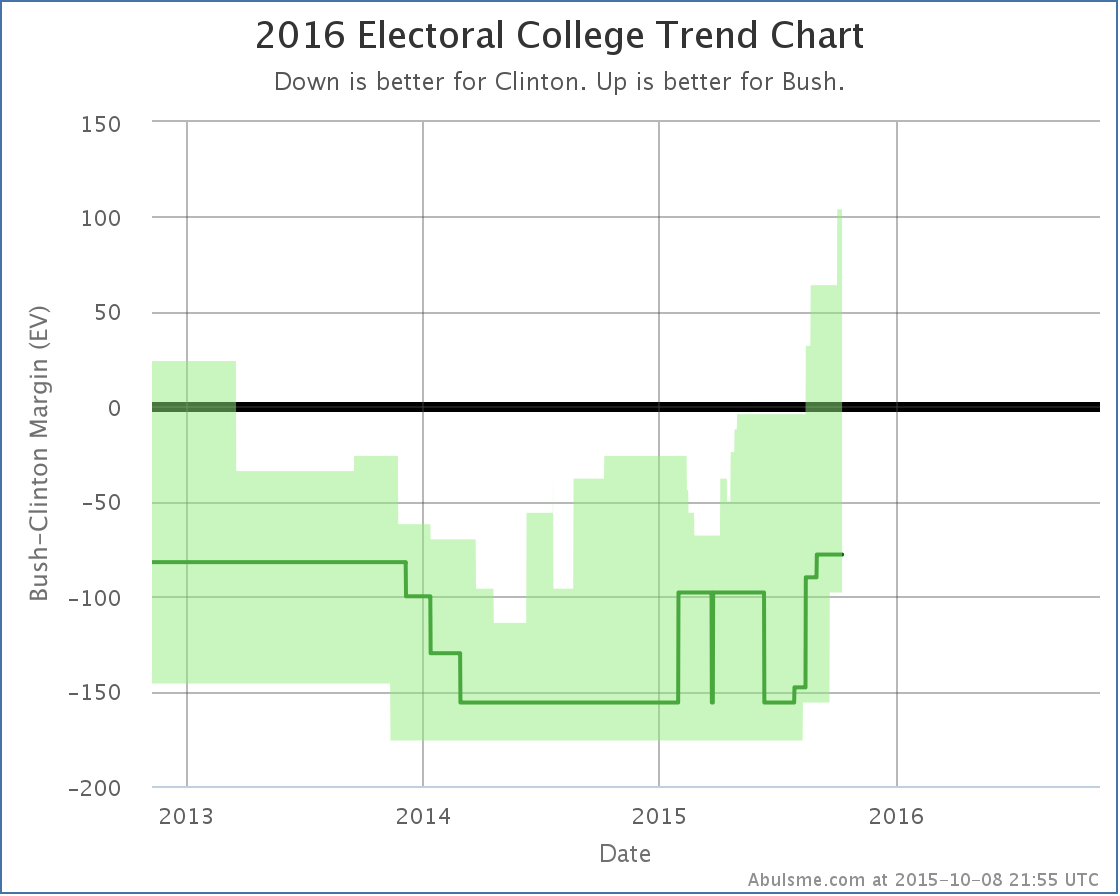
Pennsylvania moving into the realm of the possible is that spike in the upper right. Bush’s best case is now to win by 104 electoral votes. The range of possibilities isn’t quite as wide as with Rubio, but at 101 electoral votes in play, it is still pretty wide.
None of this is a prediction of what will happen in November 2016. We are still too far away for that. It is just a snapshot of where we are today.
397.1 days until polls start to close. A lot of drama yet to come in those days.
Note: This post is an update based on the data on ElectionGraphs.com. All of the charts and graphs seen here are from that site. Graphs, charts and raw data can be found there for the race nationally and in each state for every candidate combination that has been polled at the state level. In addition, comparisons of the best polled candidate combinations both nationally and each in each state are available. All charts above are clickable to go to the current version of the detail page the chart is from, which may contain more up to date information than the snapshots on this page, which were current as of the time of this post. Follow @ElecCollPolls on Twitter for specific poll details as I add them. And like Election Graphs on Facebook!
A bunch of changes today prompted by the latest Quinnipiac Swing State Poll. The TL;DR is that Clinton’s situation continues to deteriorate.
The Republicans are gaining on her, despite any talk myself or others have been doing about the Trump phenomenon hurting Republicans more generically. If that is going to happen, there is no good evidence of it yet, at least in state level general election polling.
Specifically, Rubio and Bush are nipping at Clinton’s heels. In today’s update, Bush’s best case moves into winning territory, Rubio’s already winning best case gets even better, both candidates improve their “expected” results and the tipping points are getting very close.
To actually win at this point, Rubio only needs to hold the states he already leads and flip North Carolina (Clinton +0.4%) and Pennsylvania (Clinton +2.4%). Bush has to flip a few states that are already leaning Rubio as well, but at this point he has his tipping point down to only a 3.8% Clinton lead. Easily within the reach of a campaign that goes his way.
Now the details for those who want them.
Clinton vs Rubio
Rubio moves states into better categories for him in Florida, Pennsylvania and Ohio. A quick look at all three charts:
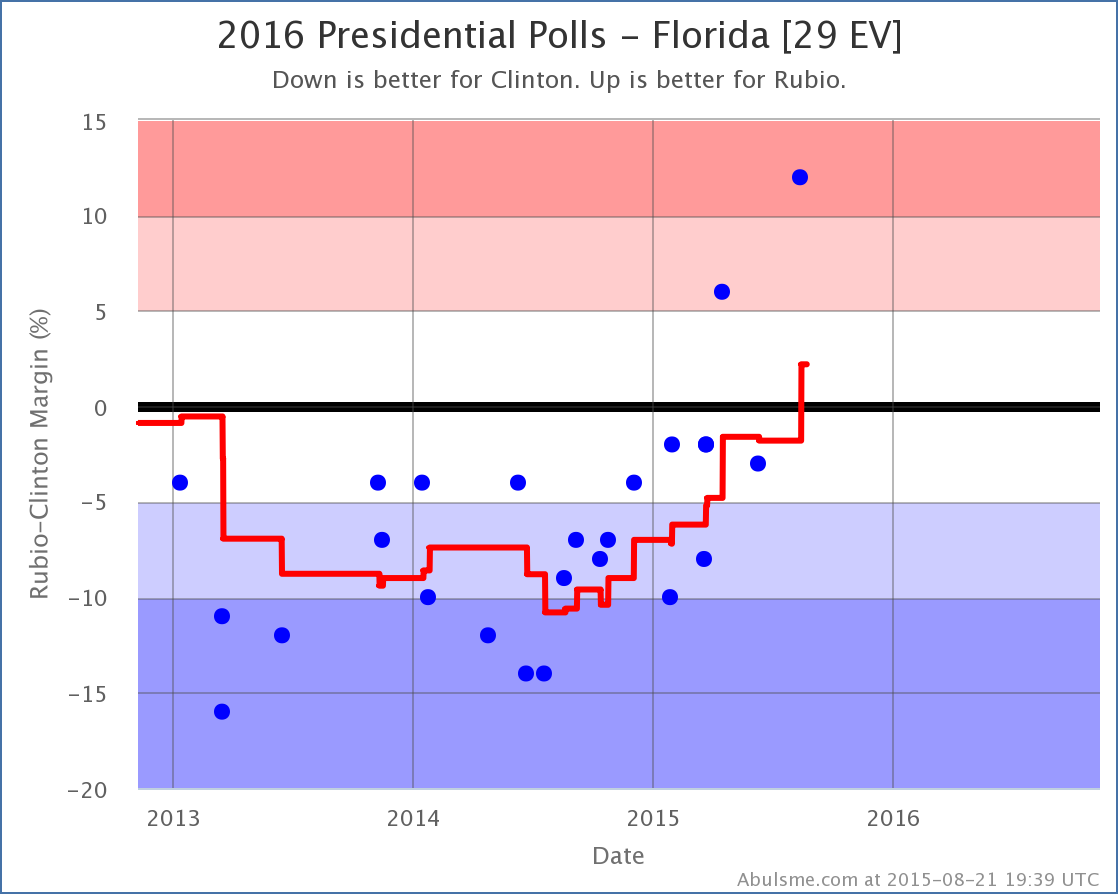
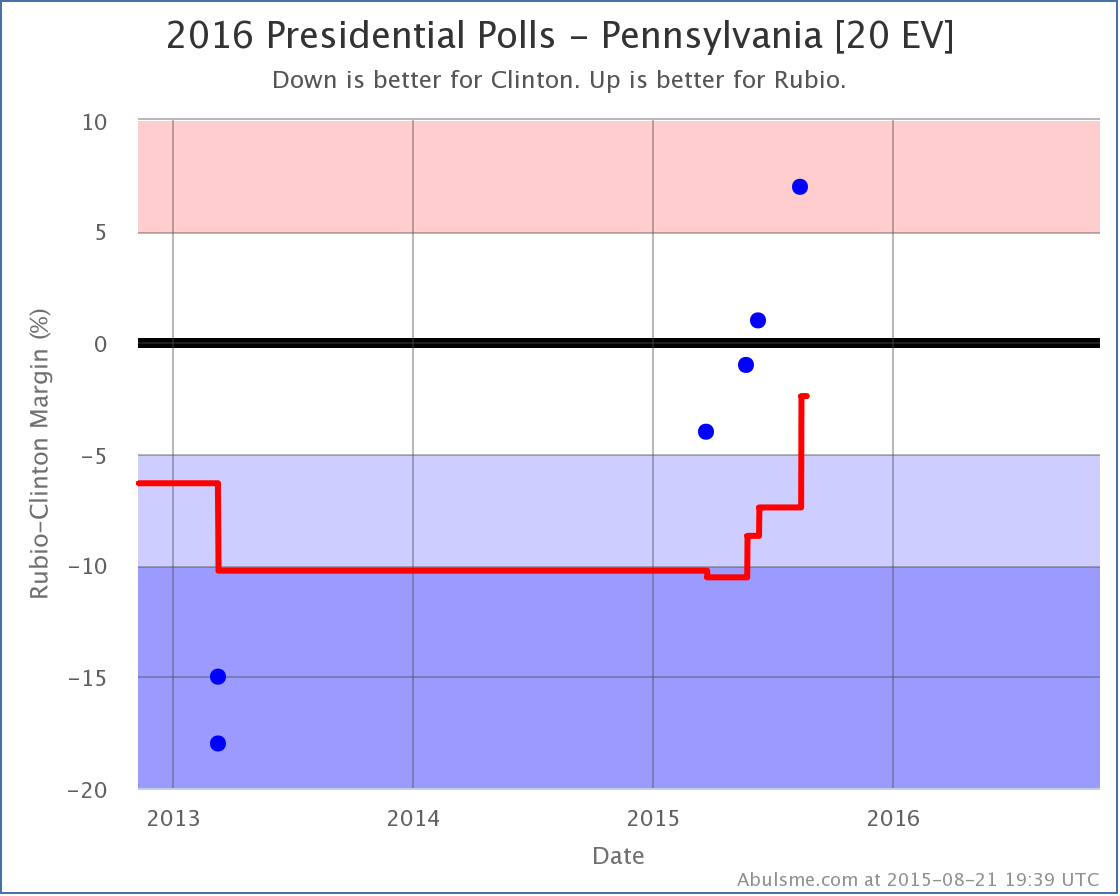
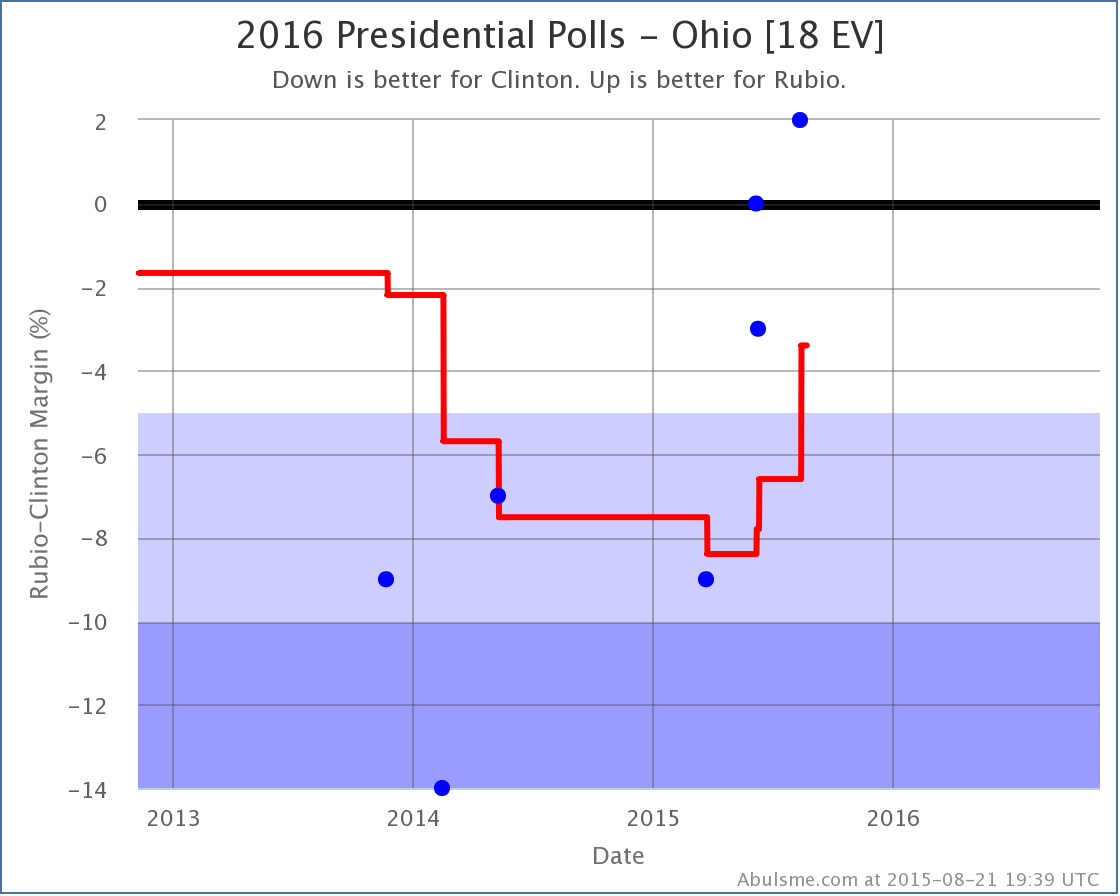
Now, an argument could be made that some of these new data points look like outliers. But we don’t know until we have follow up polls, and that is why we use poll averages and not single polls anyway, so we include the polls in the average and just see what that does.
Florida (29 ev) flips from Weak Clinton to Weak Rubio, improving Rubio’s expected result to Clinton 299 to Rubio 239. This is still a 60 point electoral point loss, but this is the best “expected case” we have seen on any Republican with a significant amount of state level polling against Clinton.
Meanwhile, with both Pennsylvania (20 ev) and Ohio (18 ev) moving from Strong Clinton to Weak Clinton, a very large chunk of electoral votes gets added into the “possible pick up” category for Rubio’s best case, which is now Clinton 227, Rubio 311… an 84 electoral vote WIN for Rubio. This is also the best “best case” we have seen for any significantly polled Republican so far.
This is what Rubio’s “bubble” looks like now:
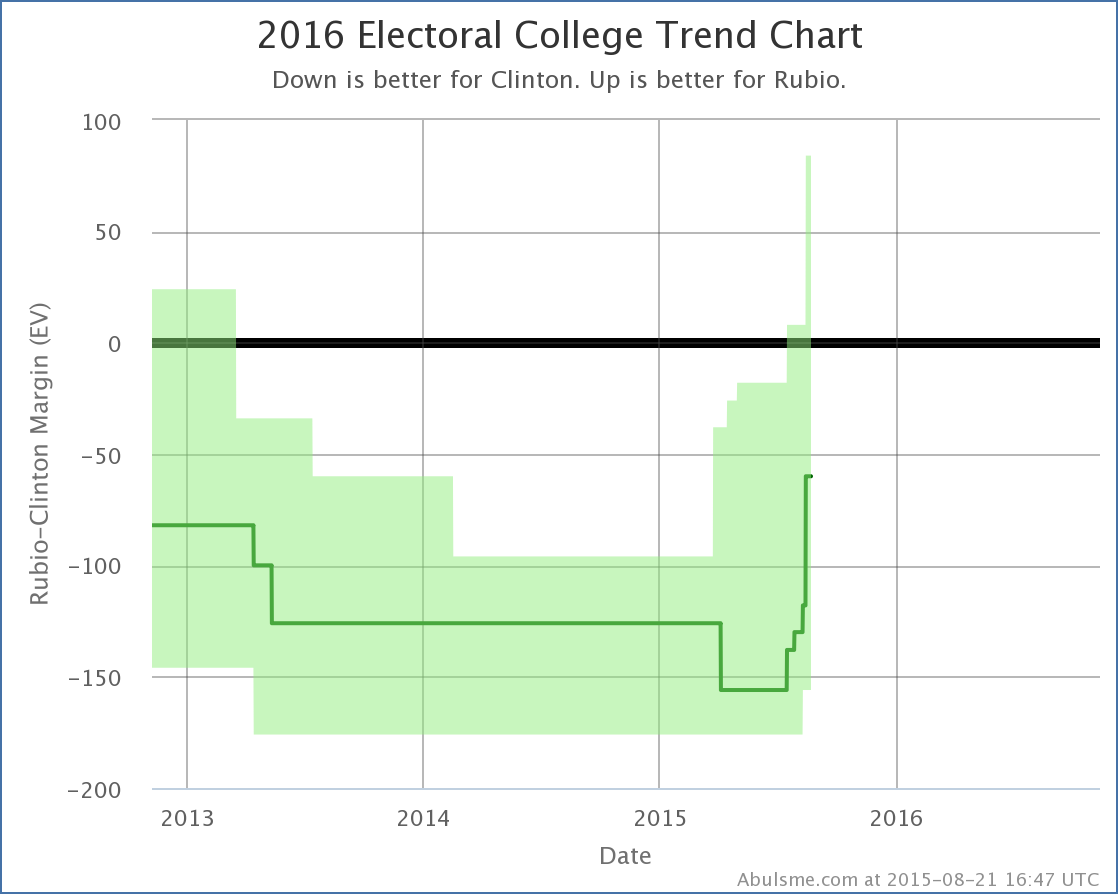
Florida, Pennsylvania and Ohio are huge electoral prizes. They make a massive difference on these charts. With a Republican in the lead in Florida, and competitive in Pennsylvania and Ohio, it really is a whole different ball game.
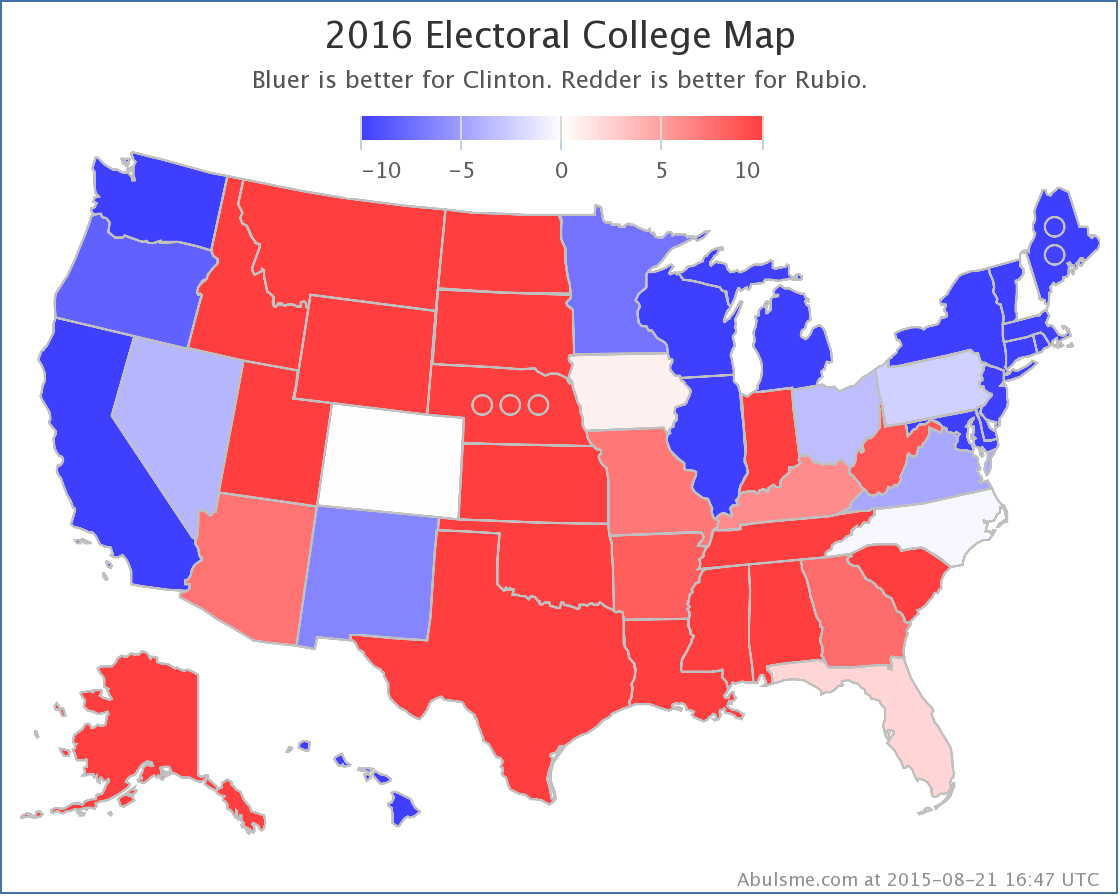
This is the Clinton vs Rubio map right now. With a map like this, Clinton still wins, but it is very very close, and the slightest issue would give the election to Rubio.
Clinton vs Bush
Looking at the Bush charts in FL/PA/OH:
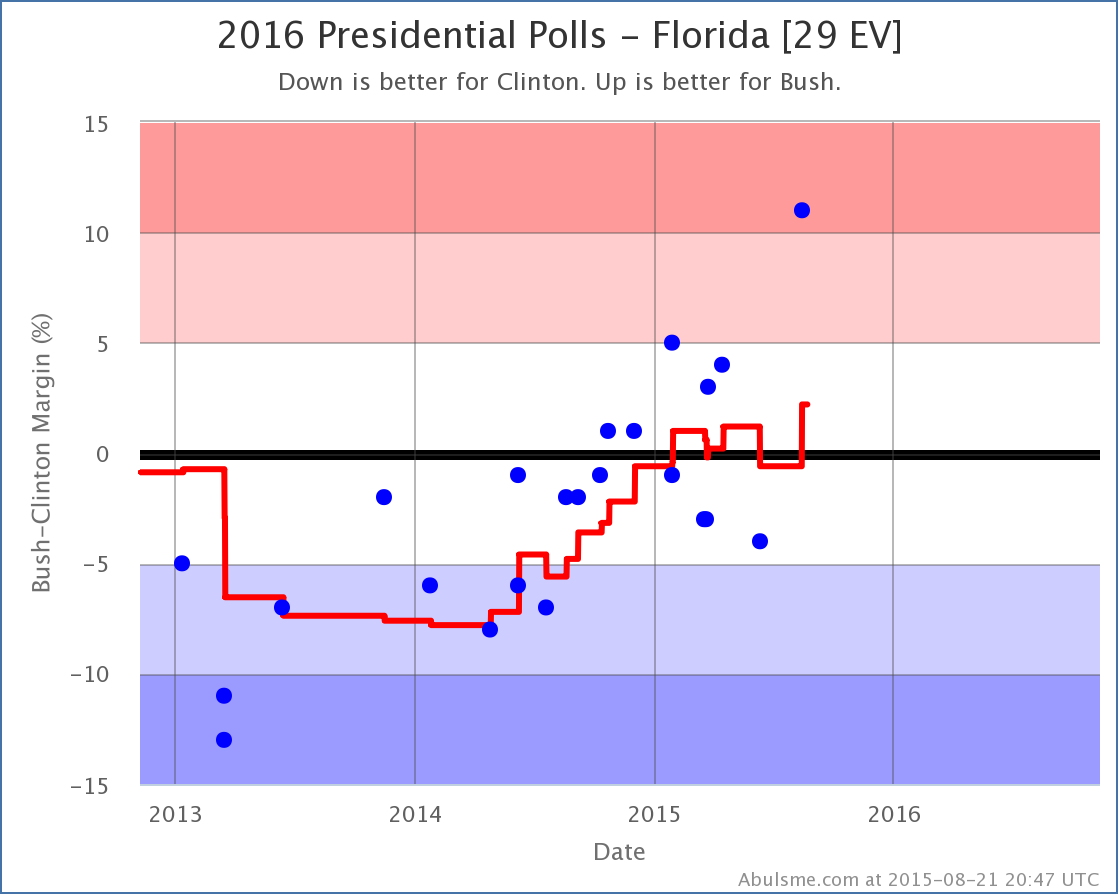
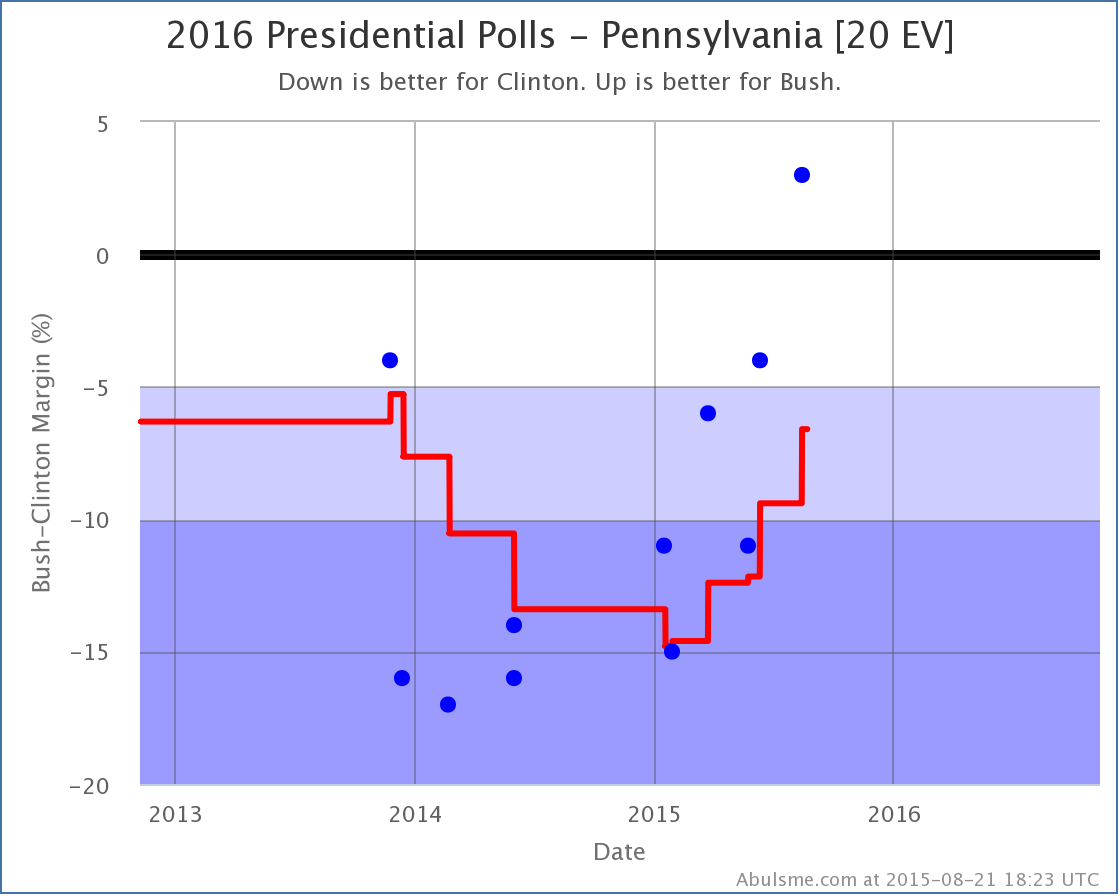
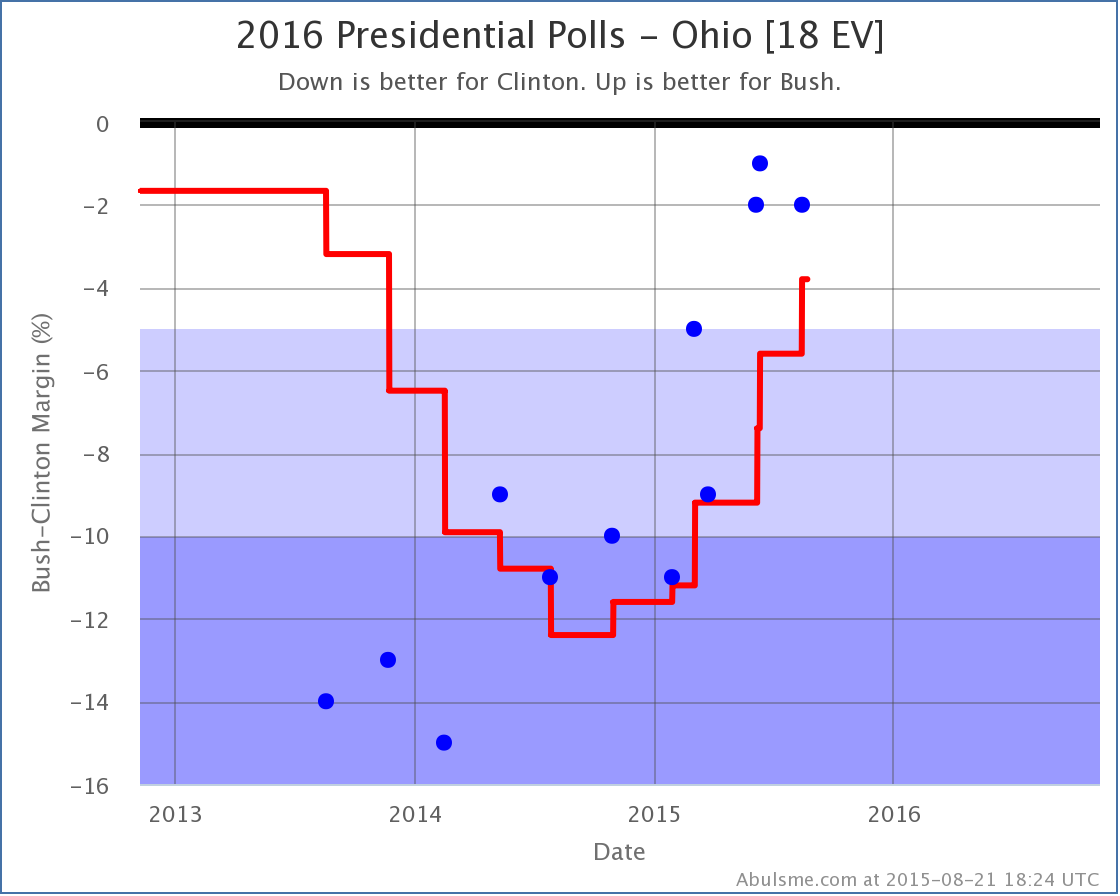
Bush also flips Florida. This improves Bush’s expected case to Clinton 314, Bush 224. This is a 90 electoral vote loss, but better than Bush has looked since late 2013.
And Bush also moves Ohio from Strong Clinton to Weak Clinton. Unlike Rubio though, he does not quite bring Pennsylvania into this category. The trend is there. Pennsylvania has been moving toward Bush all year. But Clinton’s lead is still over 5%. Perhaps that will change with the next poll. But Ohio by itself is enough to improve Bush’s best case to Clinton 253, Bush 285, which is a 32 electoral vote Bush WIN.
So we get Bush’s new bubble:
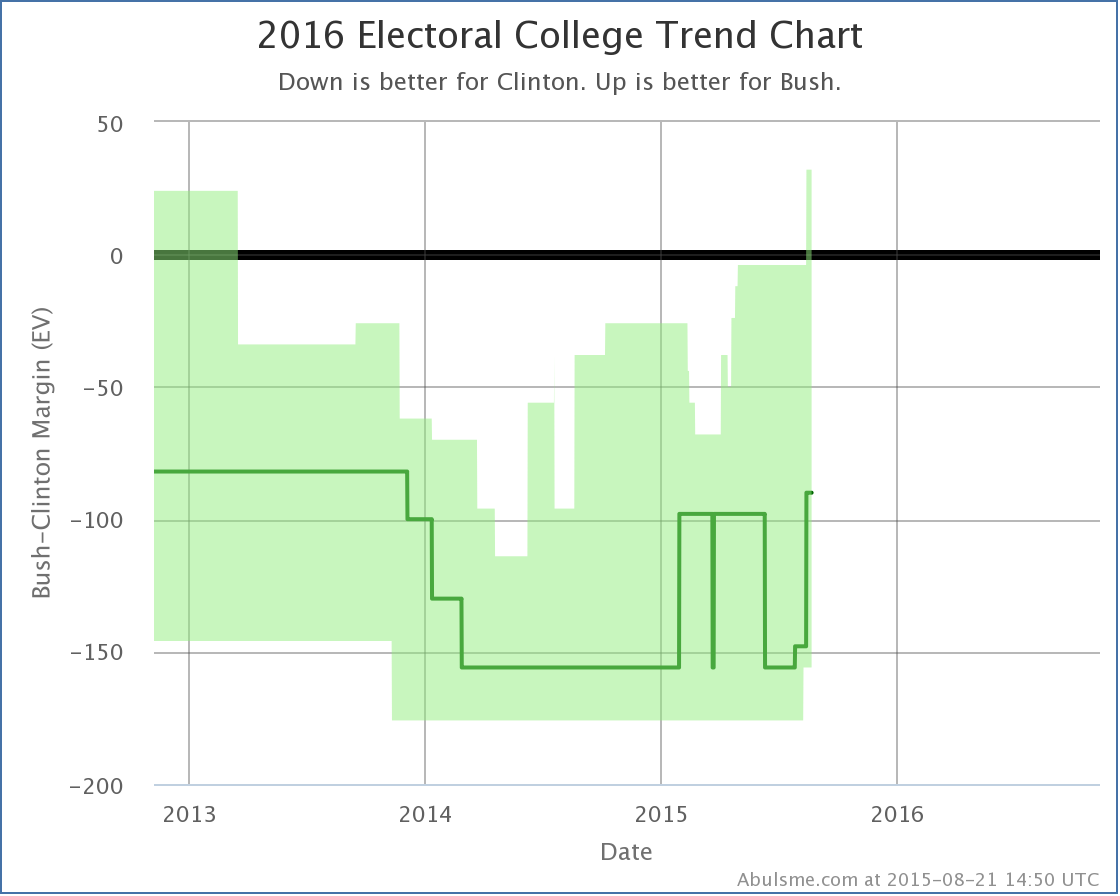
And his new map:
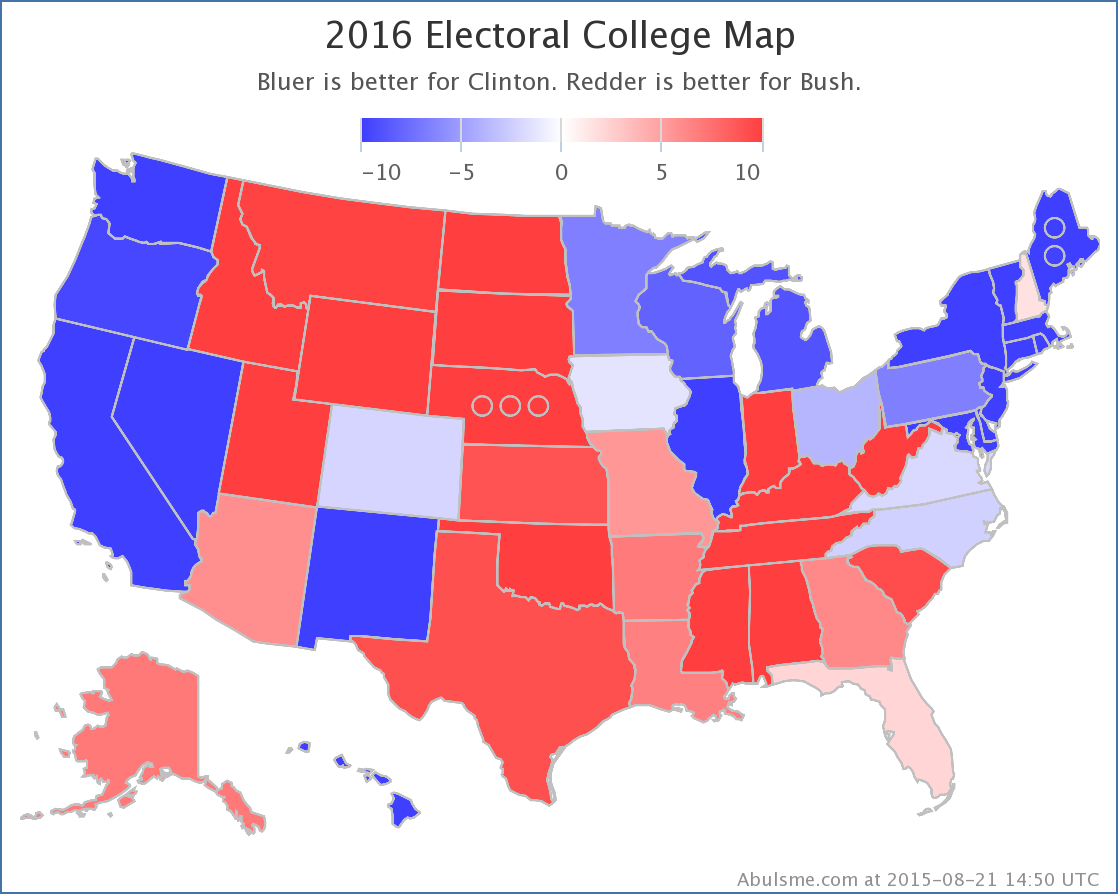
At this point, Clinton vs Bush and Clinton vs Rubio are the only two of the five best polled candidate pairs where the Republicans have a winning best case. But are the trends heading there for anybody else? Lets take a quick look.
Comparisons
Sometimes the national charts can give good comparative insight, but this time since we’ve been concentrating on FL/PA/OH, lets just look at those comparisons for now.
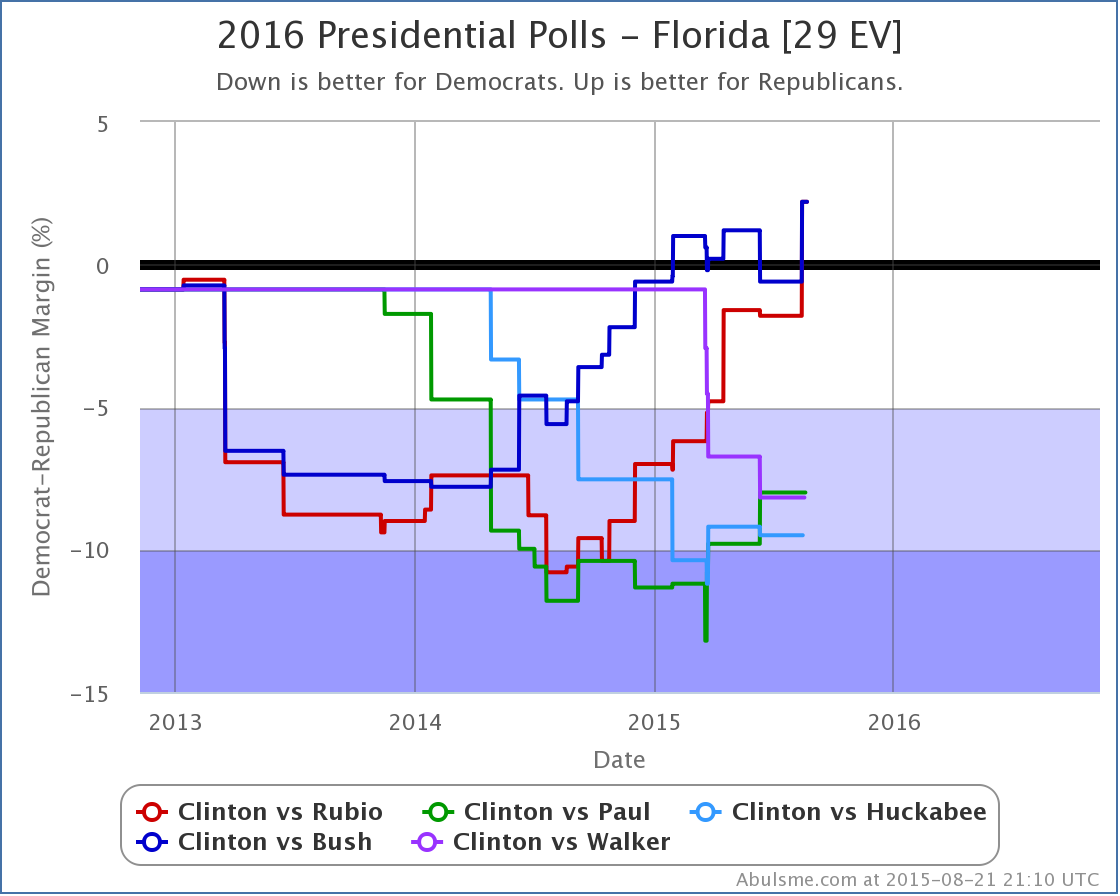
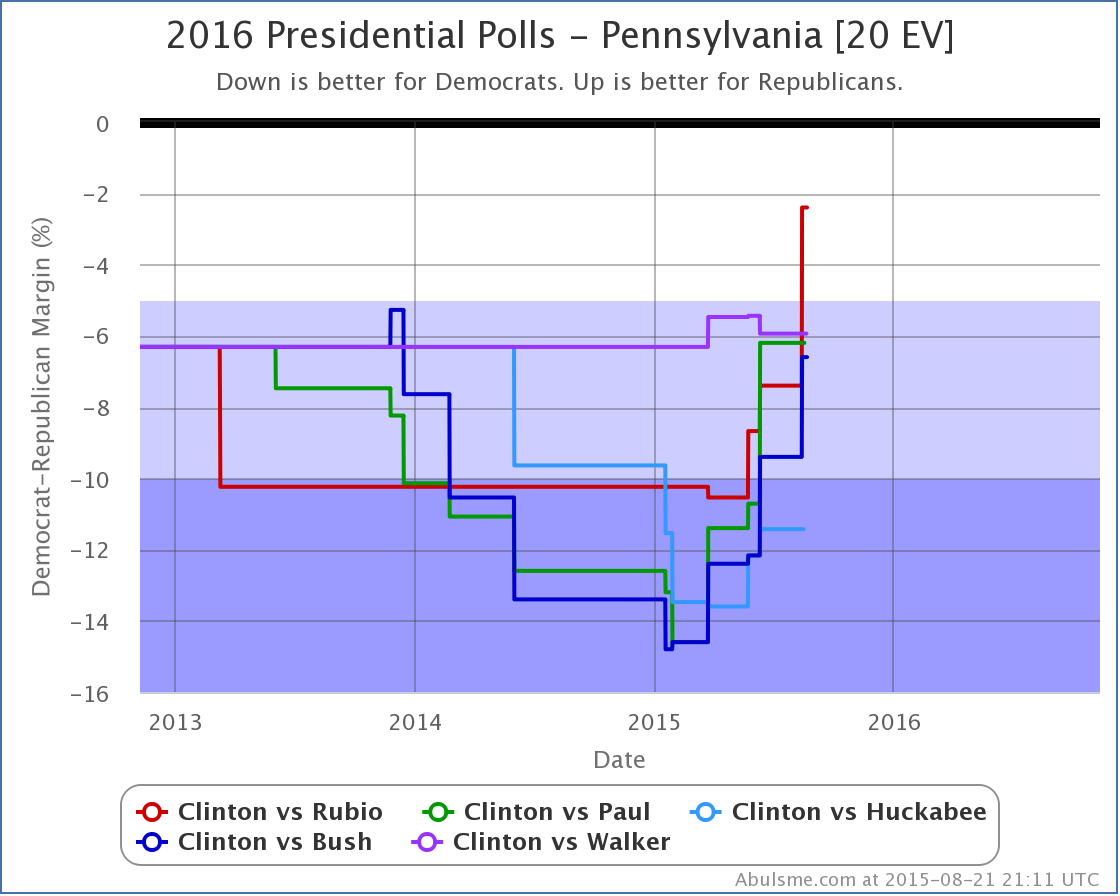
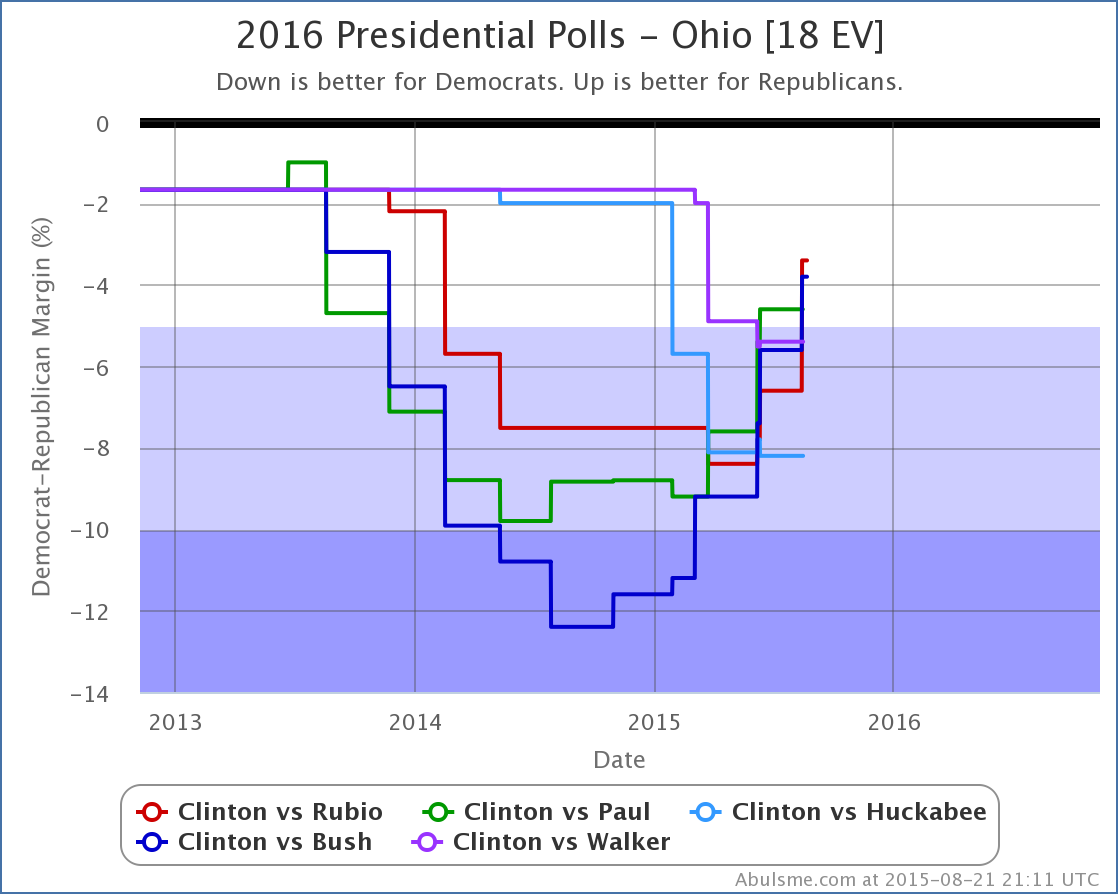
So just at a glance, in Ohio and Pennsylvania all or most Republicans are improving against Clinton. They almost seem to be moving as a bunch. (Except maybe Huckabee.)
But it looks different in Florida. In Florida, Rubio and Bush have separated themselves from the rest of the crowd. They are the only two of these five making Florida competitive. The others are just wandering around in Strong Clinton territory, with no clear trend between them.
It is very hard to map a Republican win without Florida. Possible maybe, but very hard. The trends are clearly going toward the Republicans in many states. For Rubio and Bush, Florida is doing the same. If the general trend against Clinton continues, we should start seeing other candidates gain ground in Florida too, but it isn’t in evidence yet.
But overall, Clinton is losing ground, and the race is getting closer.
445.1 days until polls start to close.
Note: This post is an update based on the data on my 2016 Electoral College Analysis Site. All of the charts and graphs seen here are from that site. Graphs, charts and raw data can be found there for the race nationally and in each state for every candidate combination that has been polled at the state level. In addition, comparisons of the best polled candidate combinations both nationally and each in each state are available. All charts above are clickable to go to the current version of the detail page the chart is from, which may contain more up to date information than the snapshots on this page, which were current as of the time of this post. Follow @ElecCollPolls on Twitter for specific poll details as I add them.
Today’s update (which included a Detroit News poll in MI and Quinnipiac polls in Florida, Ohio and Pennsylvania) brings seven changes of note to the five best polled candidate pairs. Plus Clinton vs Bush once again takes the top spot as the best polled candidate pair, but there isn’t much else to say about that. As usual, click on any of the charts for more details from election2016.abulsme.com or follow @ElecCollPolls on Twitter for detailed poll information as I add it.
Tipping Point Moves
Five of those seven changes are tipping point changes. (Reminder: The tipping point is the margin in the state that would put the winning candidate “over the top” in the electoral college.) The tipping point changed for all five of the candidate pairs, so instead of looking at them individually, lets look at the comparison:
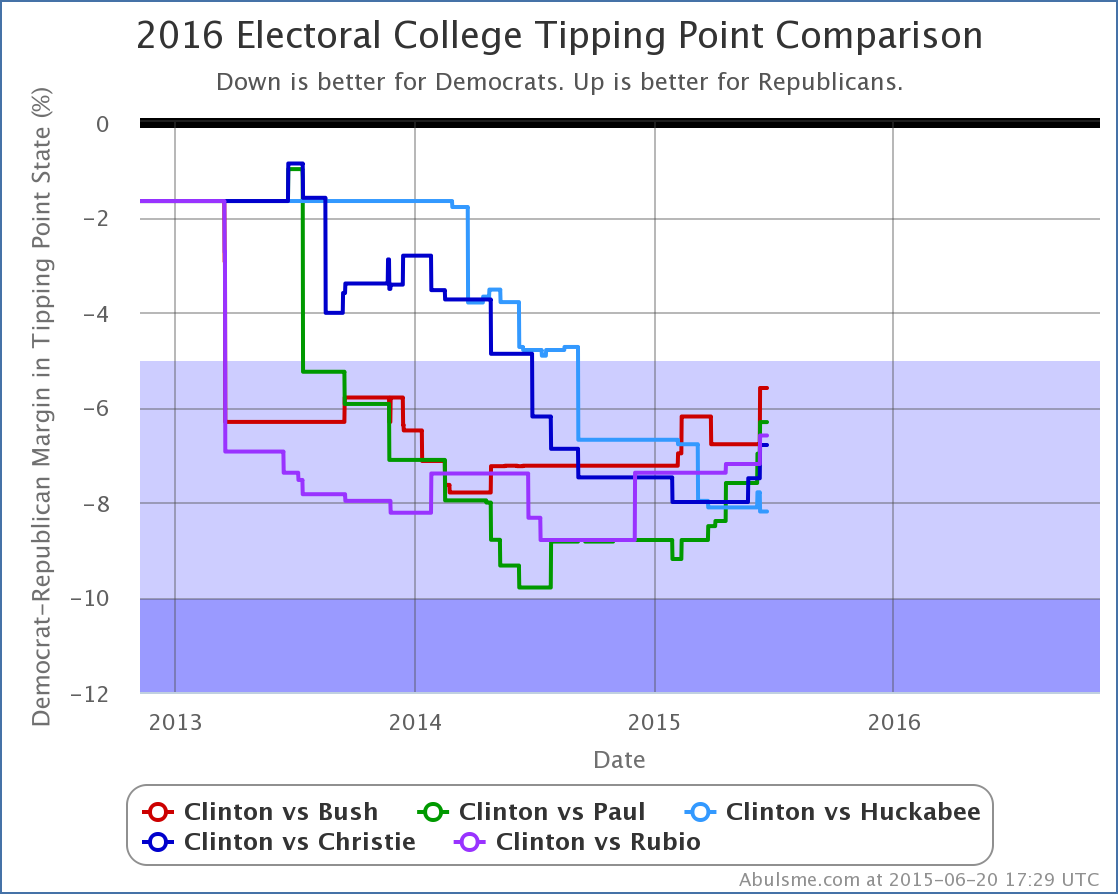
Looking both at the most recent change, and also at the change over the last three months, Bush, Paul, Christie and Rubio have all improved vs Clinton. Only Huckabee’s situation has worsened. For the candidates that are improving, the movement seems to be accelerating.
Bush’s tipping point specifically is down to only 5.6%. This still translates into a “Strong” lead for Clinton according to the categories I have defined, but we’re getting pretty close to the 5.0% boundary. Just a few more good polls for Bush in the right states, and the tipping point could move into the “Weak Clinton” zone, meaning that if Bush managed to win all of the close states (including the ones where Clinton is a little ahead) he would win. At that point, we would have an actual competitive race. Clinton would still be ahead, but a Bush win would be within the realm of reasonable possibility.
Clinton vs Bush
In addition to the tipping point changes, a couple of states changed categories. First up, Bush in Florida.
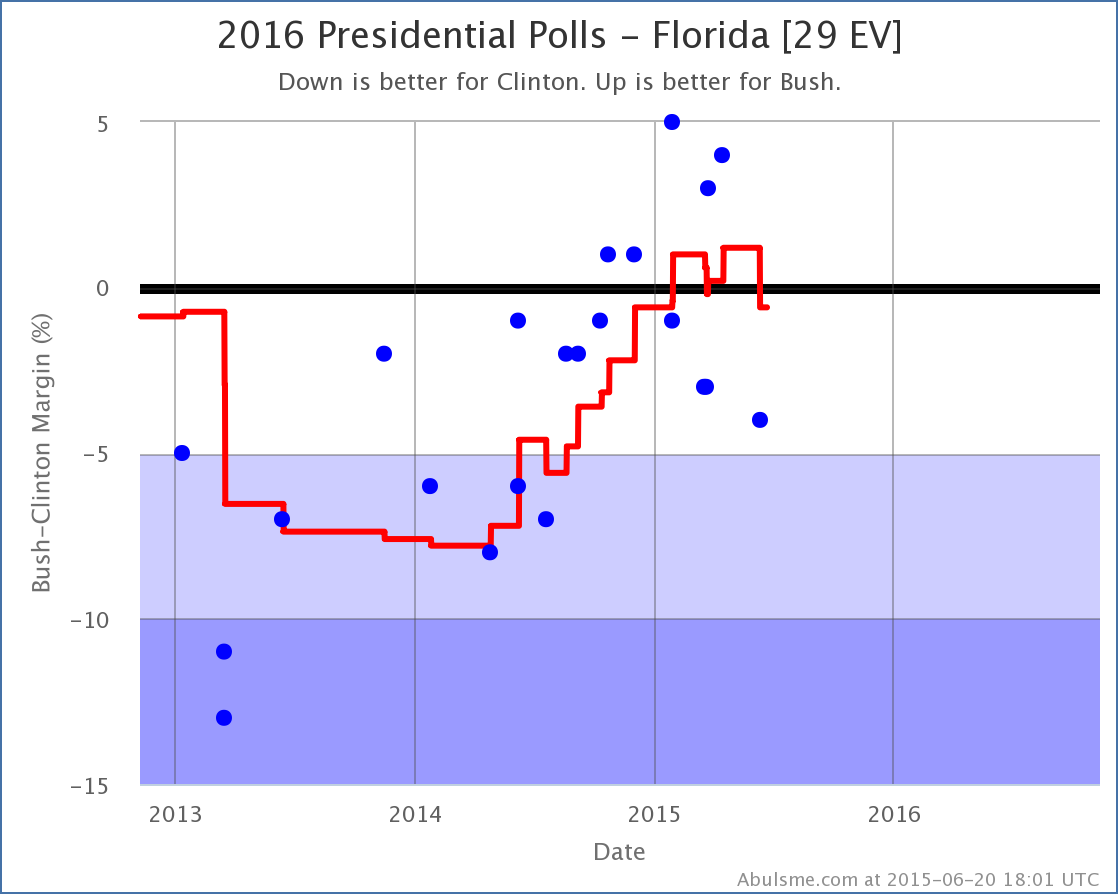
Florida moves from just barely Bush, to just barely Clinton. Bottom line, in this paring, Florida is close. Right now this is true for only Bush and Rubio. The other three Republican candidates in the top five polled pairs trail Clinton badly:
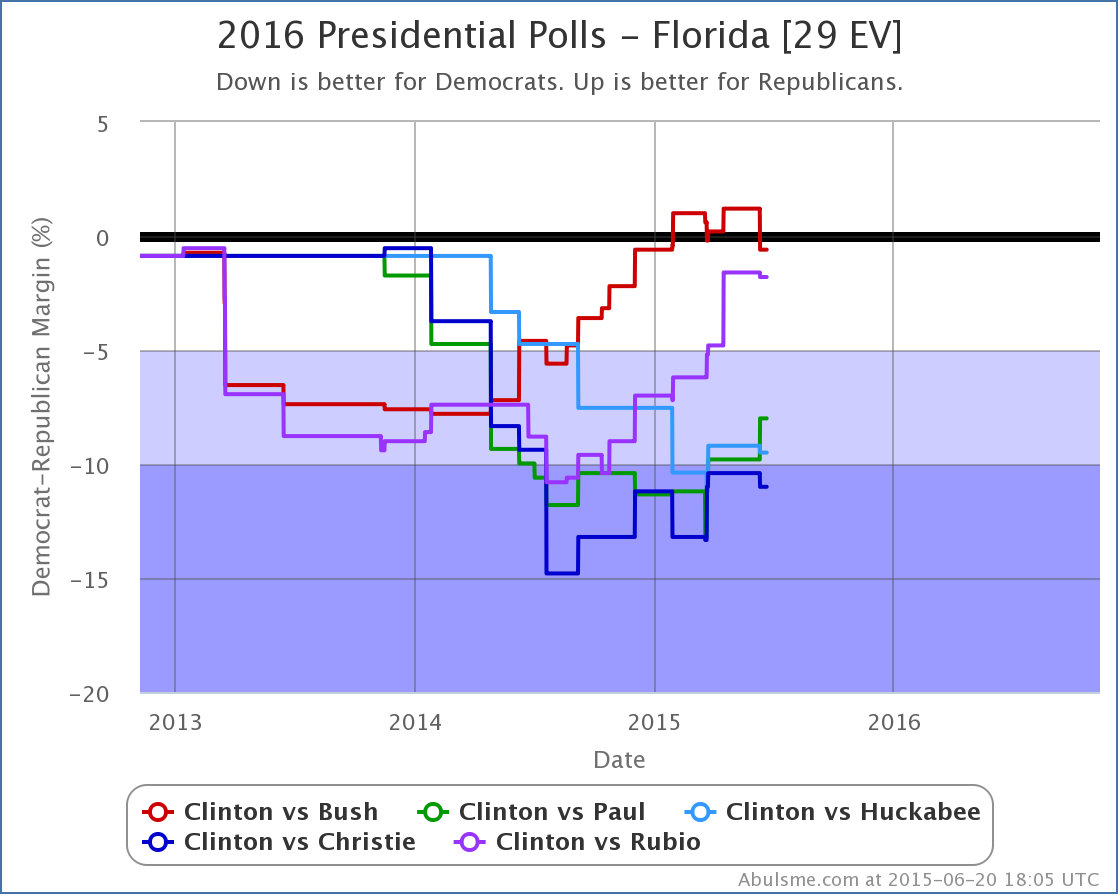
For Bush though, for the moment, Florida slips off the list of states he is ahead in, and his “expected case” drops:
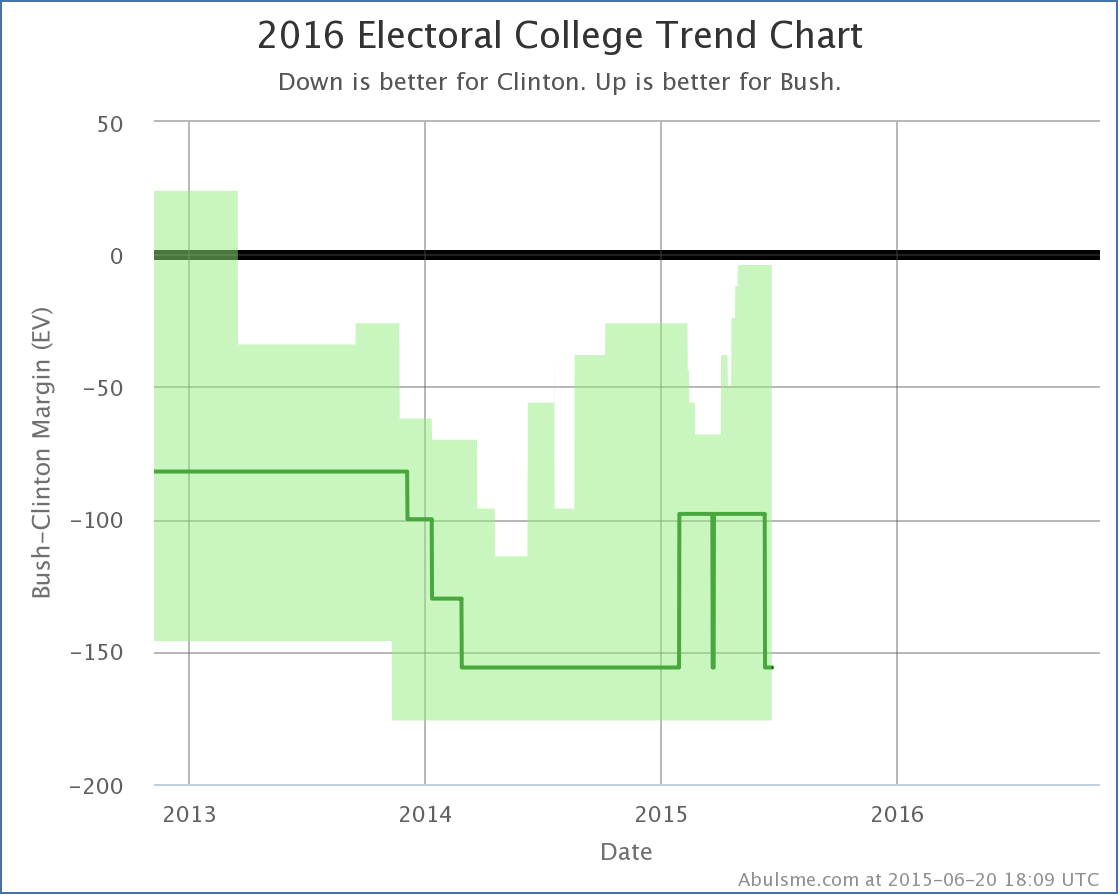
This brings Bush’s “expected” result back to Clinton 347 to Bush 191, a 156 electoral vote loss. (This is the same margin at the moment as Huckabee, Christie and Rubio… only Paul differs right now, losing by only 138 electoral votes because unlike the others, Paul is ahead in Colorado.)
Clinton vs Paul
The other category change is that in Clinton vs Paul, Ohio moves from Strong Clinton to Weak Clinton:
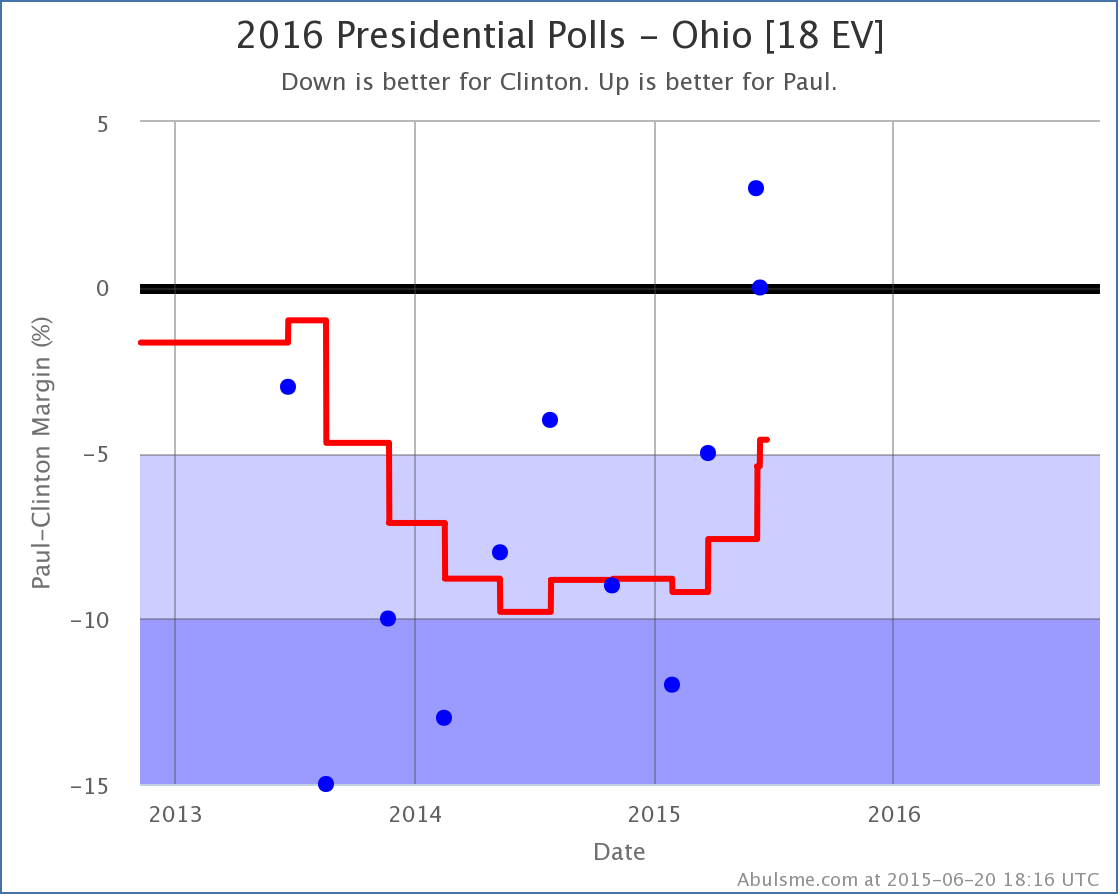
The last two polls actually show Paul ahead in Ohio. The average, which covers almost 8 months of polls at the moment, isn’t there yet, but it is moving in Paul’s direction. Ohio is looking closer and closer.
And that isn’t just Paul. If we do the comparison in Ohio, we see this movement is broader:
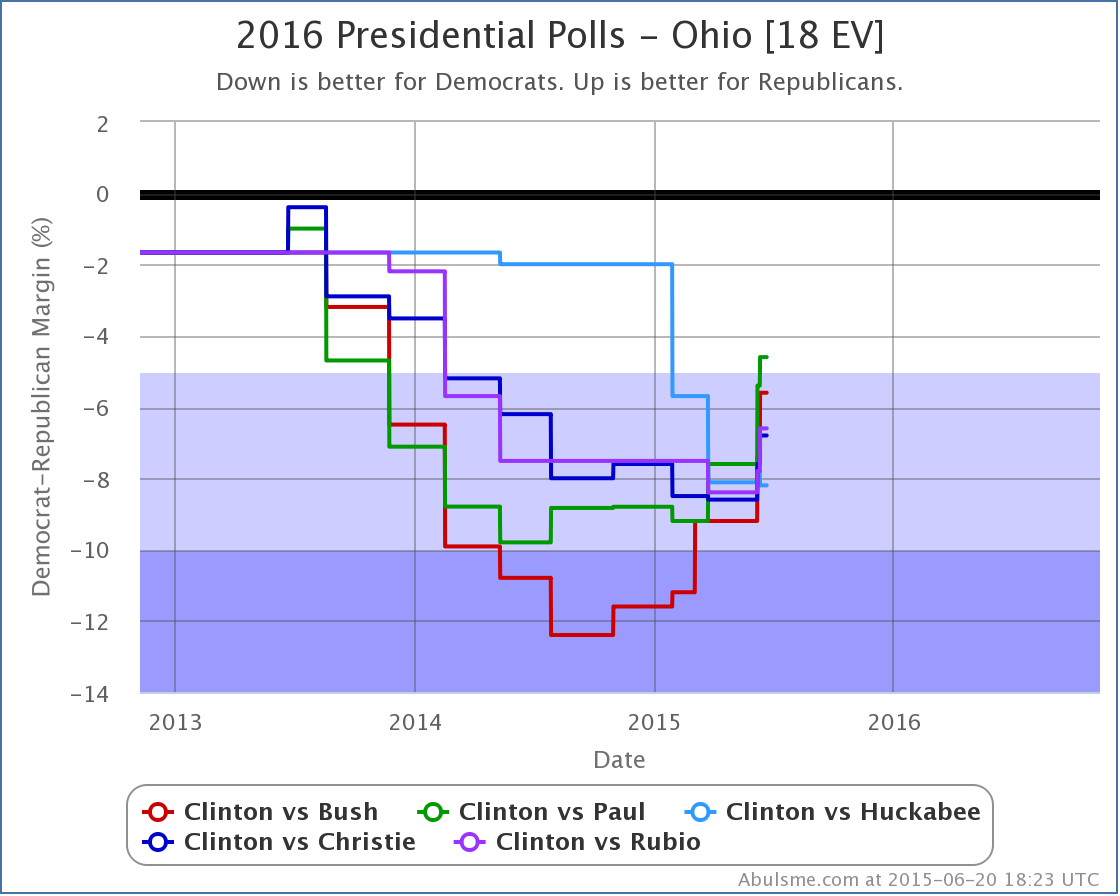
Once again, everybody except Huckabee is improving against Clinton. Or perhaps it would be better to say that Clinton is falling. Either way, Ohio is looking closer than it did. Paul is the first of these five candidates to move Ohio into the “potential win” category according to my classifications, but Bush isn’t far behind.
For Paul, this improves his “best case” where we give him all of the states he is ahead in, plus all the states where Clinton’s lead is less than 5%:
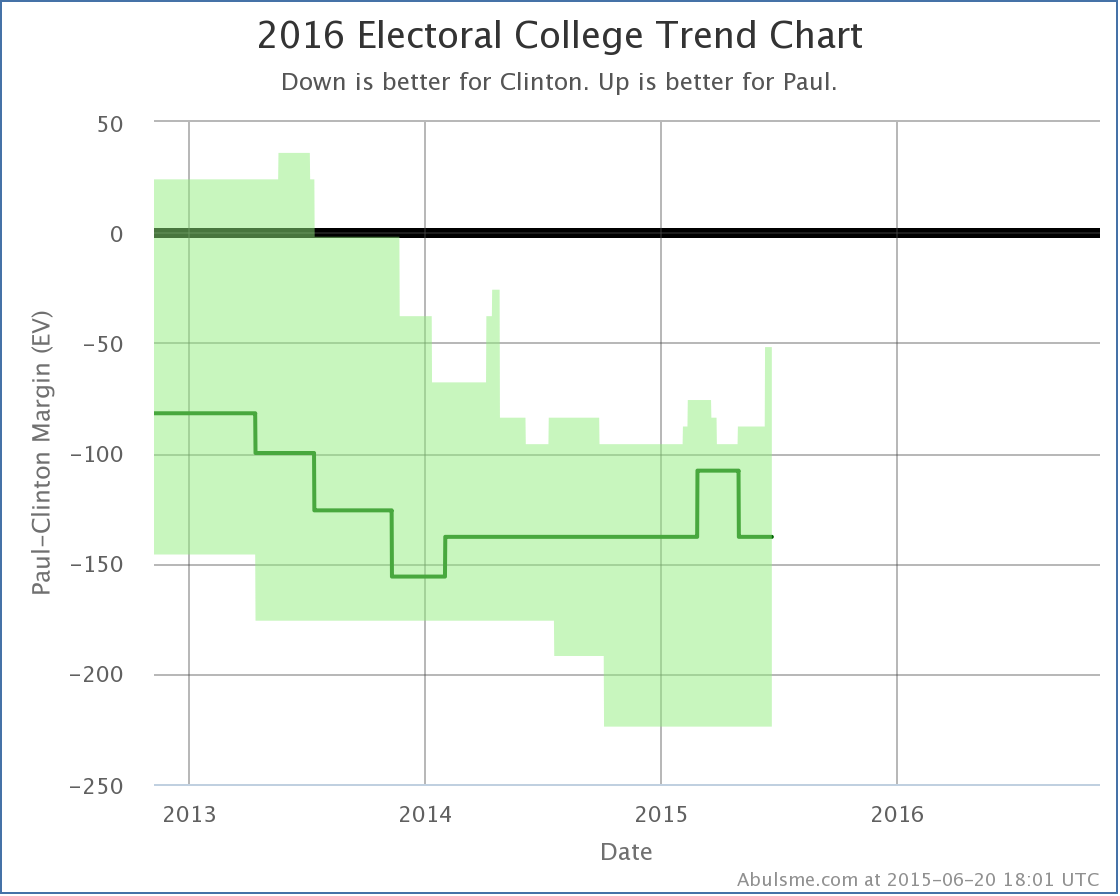
In his “best case” Paul now only loses to Clinton by 52 electoral votes. This is Paul’s best best case since I officially launched this analysis after the November election.
Pennsylvania
The polls this time around in Michigan didn’t change anything, but the ones in Pennsylvania are worth mentioning even though there were no category changes for any of the five candidate pairs.
Brandon Finnigan (@ConArtCritic) of the Ace of Spades HQ Decision Desk election tracking site tweets constantly about how Republicans should be targeting Pennsylvania as the keystone (get it?) to their election strategy. In his recent article “How The GOP Could Win Pennsylvania” he outlines the argument. So lets look at how the state is going given current polling. (Which of course will change a lot before we get to the election.)
Moves in Pennsylvania did contribute to some of the tipping point changes we talked about today, and when we look at Pennsylvania, we are seeing what looks like clear movement toward the Republicans, even though it isn’t quite switching categories yet:
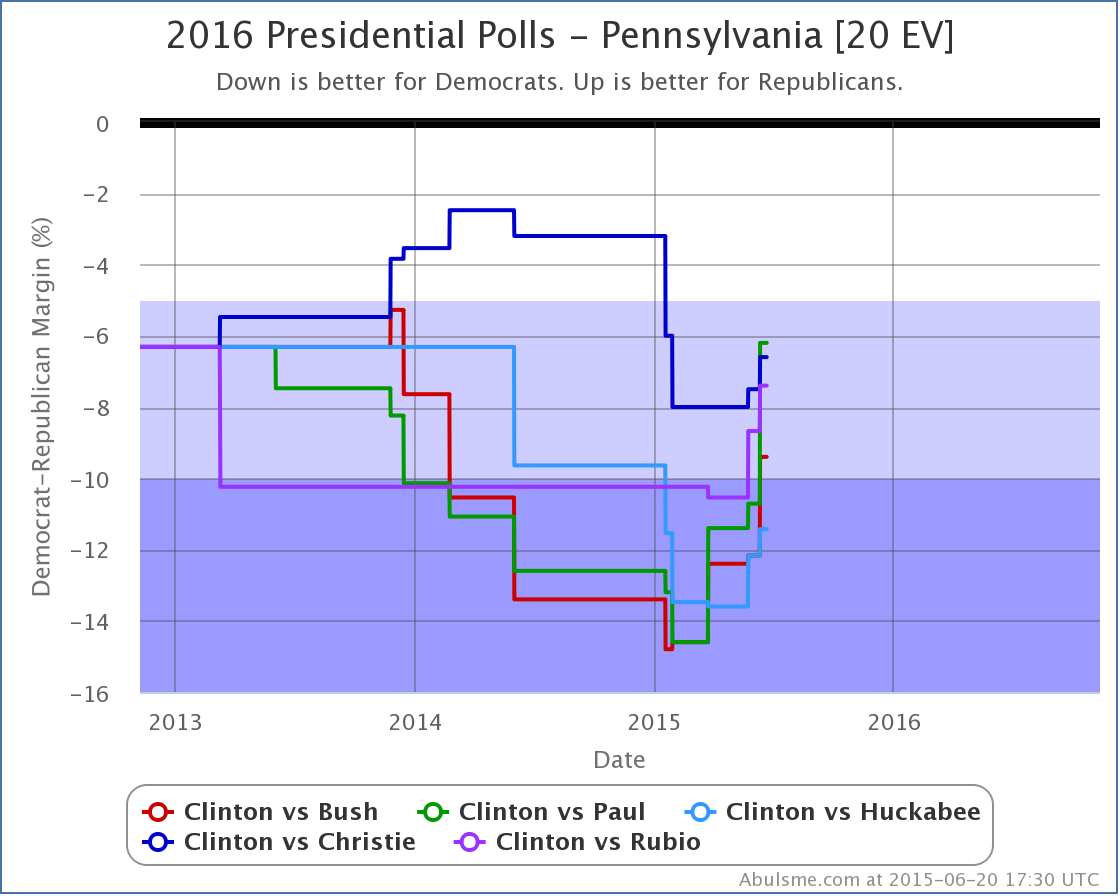
All five candidates have improved against Clinton in the last three months, some of them by large margins. Paul went from down by 14.6% in March, to down by only 6.2% right now. That is a huge move!
Now, this probably isn’t because any of the candidates are specifically targeting Pennsylvania at this point, but more likely just a reflection of Clinton’s overall decline nationally. None of the candidates have made it close in my poll averages yet, but Clinton’s margins have been narrowing rapidly.
Finnigan is certainly right that if the Republicans can make Pennsylvania close, let alone turn it red, this probably means an overall Republican victory in the electoral college, because whatever they did that could flip Pennsylvania would almost certainly flip other blue states that currently are closer than Pennsylvania as well.
Now, does that mean targeting Pennsylvania specifically rather than going after those closer states first is the best strategy? I don’t know.
For Bush for instance, if you start with the states he is already ahead in and then see which states he would need to flip to win, you get this list (in order by how far behind Bush is right now in my poll averages):
At that point Bush would have enough electoral votes to win. To get to Pennsylvania on this list, you’d have to also go past Minnesota, Nevada, Wisconsin, and Michigan. Then Pennsylvania.
Would it be better to concentrate directly on the seven states above? Or is jumping forward to Pennsylvania’s 20 electoral votes somehow an easier path? If Pennsylvania is specifically more vulnerable due to some of the factors Finnigan mentions, then maybe.
I think Finnigan’s point is broader than that though. It isn’t that Pennsylvania is a better target than Ohio or Colorado, although maybe it is. It is more that if the Republicans took Pennsylvania seriously, and did everything they needed to do to win Pennsylvania, then those same things could be applied more broadly, and a lot of other states would move too, and the Republicans would not just win, but win clearly, not a “just barely” sort of win like they got in 2000 and 2004.
The movement we’re seeing so far does show that Pennsylvania is movable. Can it move enough to make it red? I have my doubts absent the Democratic candidate simply collapsing on a nationwide basis. But Pennsylvania might be worth watching anyway…
Bottom Line
Aside from Florida moving her direction but remaining pretty close, and Huckabee generally not doing well, Clinton seems to be continuing to weaken against most Republicans. This reflects the campaign beginning to get under way in earnest, and the name recognition gap slowly diminishing. The question is where this trend ends. After a few debates happen, do we reach some sort of steady state Clinton lead a bit narrower than it is today, or do the Republicans continue to gain on her until we really have a race that could go either way, or even with Republicans in the lead?
As usual, stay tuned. 507 days to go!
Note: This post is an update based on the data on my 2016 Electoral College Analysis Site. All of the charts and graphs seen here are from that site. Graphs, charts and raw data can be found there for the race nationally and in each state for every candidate combination that has been polled at the state level. In addition, comparisons of the best polled candidate combinations both nationally and each in each state are available. All charts above are clickable to go to the current version of the detail page the chart is from, which may contain more up to date information than the snapshots on this page, which were current as of the time of this post. Follow @ElecCollPolls on Twitter for specific poll details as I add them.
Edit 23:07 UTC to add some additional links to the election site and Twitter.
I added some recent results from PPP in Pennsylvania today. PPP polled 13 candidate combinations. Of these only one resulted in a change worth noting in one of our top five best polled candidate combinations. (I consider it a change worth noting if the expected electoral result changes, or the “best case” of one of the two candidates changes, or the tipping point changes.)
Clinton vs Christie
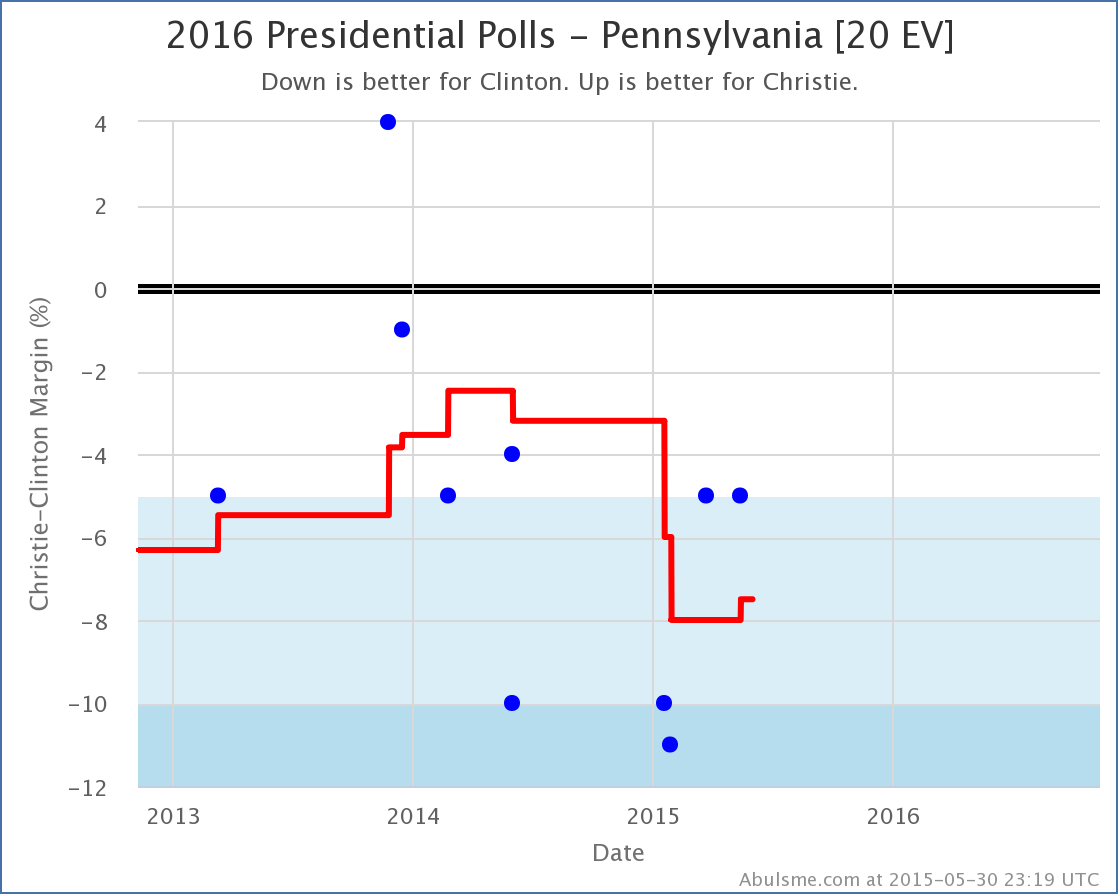
The polling average (which actually contains 6 polls right now rather than the usual five since there is a tie for fifth oldest poll by middate) still shows Clinton with a “Strong” lead, but slightly less of a lead than before. The state doesn’t change categories though, it isn’t close to a “Weak Clinton” state. But it turns out that in Clinton vs Christie, Pennsylvania was the tipping point state, so the topping point changes.
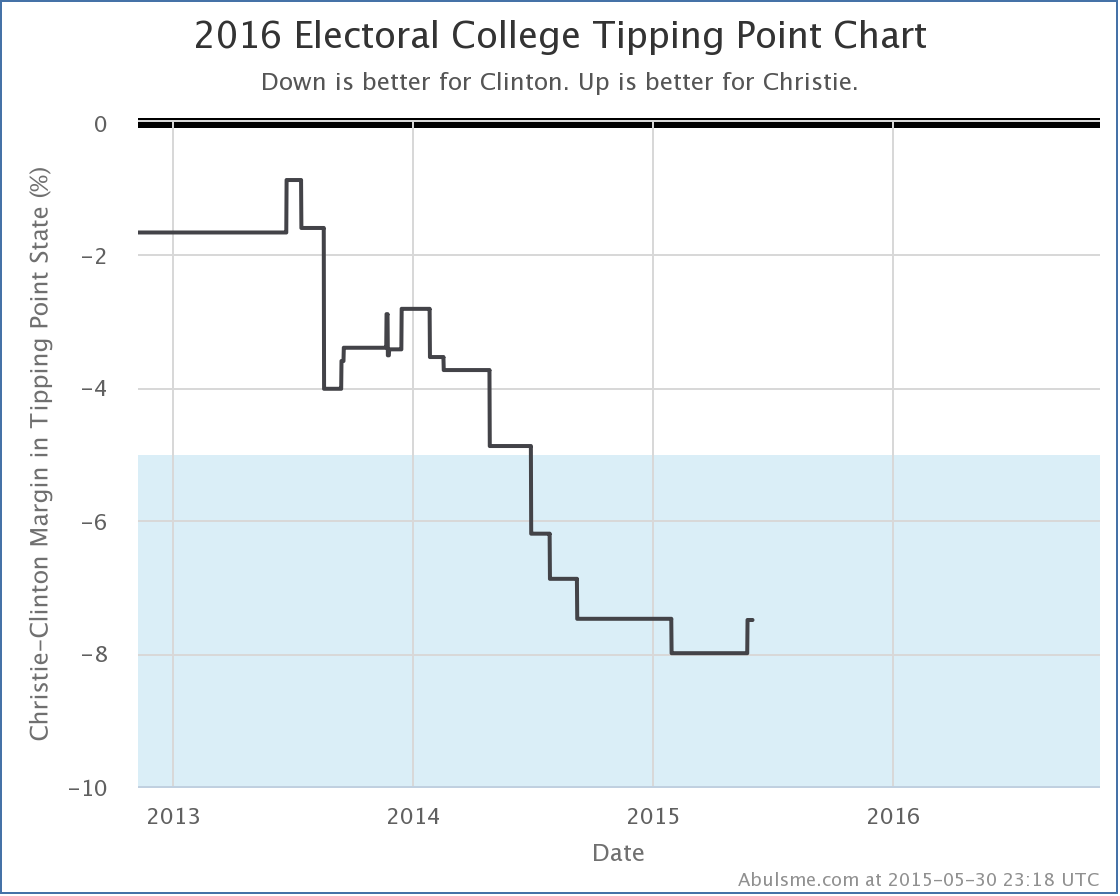
For those who don’t remember, the tipping point is determined by sorting the states by the support level of the candidates, and then seeing which state is the one that would put the winning candidate over the edge. By then looking at the margin in that state, you see how far ahead polls would have to swing on a national basis to change the outcome of the election. In other words, this is a bit like looking at national popular vote numbers, but taking into account the structure of the electoral college. More than most of the other numbers I look at, this represents how far ahead (or behind) a candidate is.
In this case, the tipping point was Pennsylvania, where Clinton was ahead by 8.0%. With the new poll added, the tipping point is still Pennsylvania, but Clinton’s lead is down to 7.5%.
This is the first improvement for Christie in ANY of the metrics I track for Clinton vs Christie since February of last year. Is this the sign of a resurgence for Christie? I kind of doubt it. That ship may have sailed. But it may represent him getting to the point where he won’t get any lower.
The Others
It is worth looking at how some of the other candidates are doing in Pennsylvania though. Here are the Pennsylvania trends for the five best polled candidate combinations at the moment:
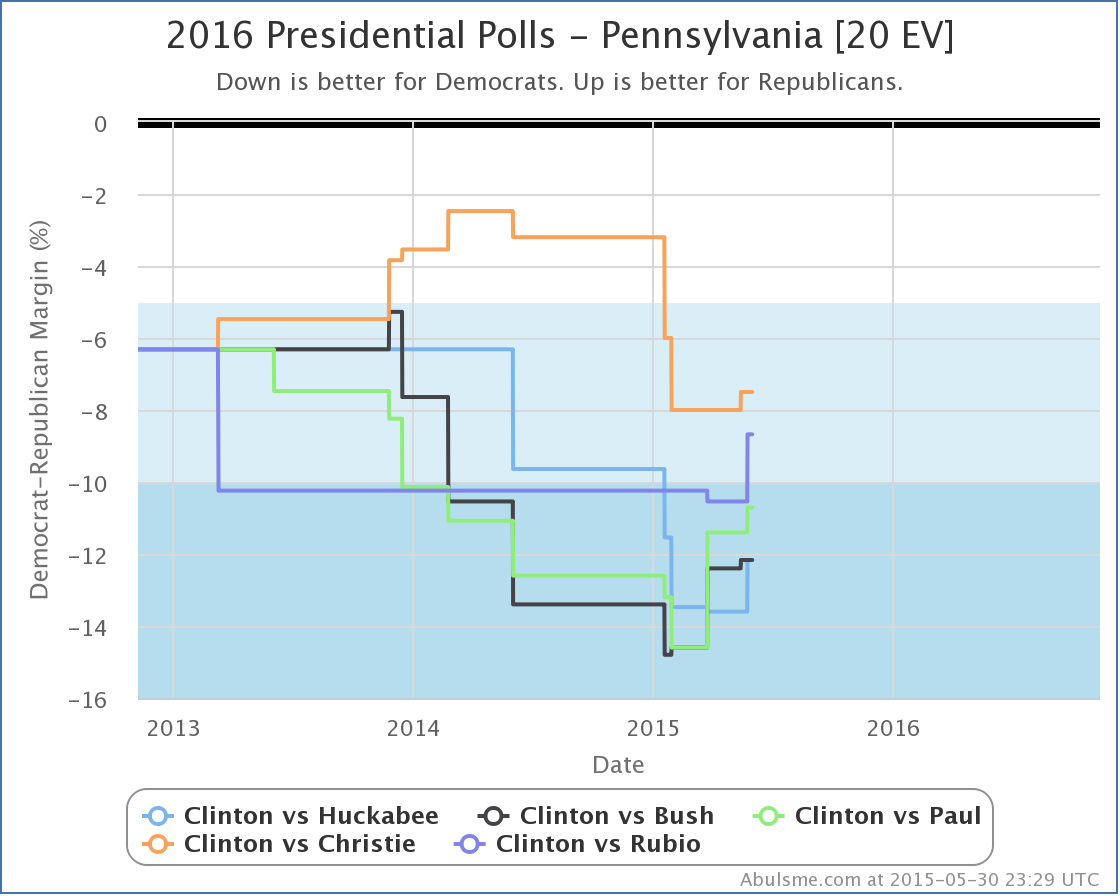
With Christie now enjoying an upward tick of his own, all five Republicans have been improving in Pennsylvania in the last month or so. Bush, Paul and Rubio are all better off than they were at the November elections as well. (Huckabee and Christie are still down from where they were at that point despite the bump in the last month.)
Some of the most recent individual polls in Pennsylvania actually have the state close for some of these candidates against Clinton, but the average isn’t there yet. It is showing movement though. So it is certainly possible we will see further polls confirm Pennsylvania getting closer. Pennsylvania is a big state (20 electoral votes). If Pennsylvania is in play, it opens up a lot more possibilities for the Republicans. So keep an eye on the polls here.
Note: This post is an update based on the data on my 2016 Electoral College Analysis Site. All of the charts and graphs seen here are from that site. Graphs, charts and raw data can be found there for the race nationally and in each state for every candidate combination that has been polled at the state level. In addition, comparisons of the best polled candidate combinations both nationally and each in each state are available. All charts above are clickable to go to the current version of the detail page the chart is from, which may contain more up to date information than the snapshots on this page, which were current as of the time of this post.
Today’s poll update was the addition of the Quinnipiac Swing State Poll, which included Florida, Ohio and Pennsylvania. Within the five “best polled” candidate combinations, this caused three changes worthy of note here. All three were moves toward Clinton and away from the Republicans.
First up, since it is the only one that actually involves changing the electoral summary for a candidate pair… Clinton vs Huckabee.

This is only the second time Clinton vs Huckabee in Ohio has been polled, but both new polls pull the state more toward the Democrat than the average of the last five presidential elections (which gave a 1.7% Dem advantage). This latest Ohio poll pulls the five poll average to a 5.7% lead for Clinton, which takes the state out of the “Weak” category which I allow to swing back and forth between the candidates to produce the “Best Case” scenarios for each candidate.
With the loss of Ohio from the list of “Possibles”, Huckabee’s “best case” moves from Clinton by 14 EV, to Clinton by 50 EV.
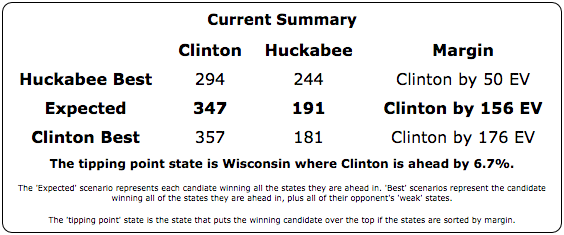
Of the five “best polled” candidate combinations, Clinton vs Huckabee is still #5 with much less comprehensive polling than Paul, Bush and Christie, so this may still be overstating where Huckabee would really be if more states were more fully polled.
The next two changes don’t actually change the Expected or Best cases for candidates, but rather are just changes to the “Tipping Point”. The tipping point essentially describes how much polls would have to move nationally (assuming an even distribution of movement in all states) to change who has the lead in the electoral college… in other words, how far ahead or behind the candidate is overall.
So next up is Clinton vs Paul:

With the new poll, Paul moves from being behind 8.8% in Ohio, to being behind 9.2% in Ohio. Both of these are in the “Strong Clinton” category, so there is no category change here, but Ohio was the tipping point state in this contest, and so any movement in this state will generally mean movement in the tipping point.

As you can see, the Clinton vs Paul tipping point has been between an 8% and 10% Clinton lead for most of the last year, so this isn’t breaking any new ground. The trend before last summer on this chart was basically just the process of getting enough polls to have a good view of this candidate pair, so things have essentially just been pretty flat since then. The new change doesn’t really change that, although I’m sure Paul would still rather see this line go in the other direction. (Well, if Paul was looking at my charts, which he isn’t. :-) )
Finally, Clinton vs Christie. This time, the changes in two states were relevant:

Last week I talked about Christie fading in Pennsylvania. The new polls today reinforce that trend, further worsening Christie’s position in Pennsylvania. It dropped him from being behind by 6.0% to being behind 8.0%, which pushed Pennsylvania past the previous tipping point of 7.5% in Minnesota.

Now, Ohio also moved away from Christie with today’s polls (from Clinton by 7.6% to Clinton by 8.5%). If it hadn’t, Pennsylvania would have pushed past Ohio too, which would have had a different result for the Tipping Point.
In the end, the tipping point for Clinton vs Christie moved from Clinton by 7.5% in Minnesota, to Clinton by 8.0% in Pennsylvania.

Unlike Clinton vs Paul, with Clinton vs Christie we’ve basically just been seeing a continued trend away from Christie and toward Clinton. Christie has not been faring well lately on this front.
Before closing up, lets look at a couple of the comparison charts between the five best polled candidate pairs.

With Huckabee’s decline in best case, the Republican with the best best case against Clinton is now Bush, but that Best case is still losing by 26 electoral votes. (And the expected case if Bush did NOT manage to flip all the Weak Clinton states is Bush losing by 156 electoral votes.)
The worst best case versus Clinton is still Paul, losing by 96 electoral votes even if you give him all the Weak Clinton states. (Paul’s expected case is a bit better than Bush though, only losing by 138 electoral votes.)

It looks a little different in terms of tipping point, with Huckabee doing best this time (behind by 6.7% in Wisconsin). Paul still in the rear here, behind by 9.2%.
Now, as people keep pointing out, and I will too, polls this far out from the election are NOT PREDICTIVE. All of the charts I’ve shown above say NOTHING about what the actual results in November 2016 will be. NOTHING.
However, that does NOT mean they are meaningless, or that they should be ignored. (Or why am I bothering with all this?) No, polls right now still give you a sense as to where things stand TODAY, which while it won’t tell you who will win 643 days from now, it DOES tell you how much work the candidates who are currently behind have to do in order to flip things. (Alternately, how much wiggle room the candidate in the lead has available as buffer against mistakes they might make.)
So, yes, pay attention to the polls. Even now. Just don’t make the mistake of believing that just because Clinton is way ahead of everybody now that necessarily means that will still be the case in a year and a half, when the polls DO start having some predictive power.
PS: There was also a tipping point change today for Clinton vs Romney but even with today’s new polls, Clinton vs Romney is still only the 20th best polled candidate combination, and with Romney declaring he isn’t going to run after all, he’s no longer as likely to climb the ranks as I thought a few weeks ago. If I had to guess as to the next change in the “Top Five” it would be Clinton vs Rubio (currently #7, but Rubio actively talking about being a candidate) replacing Clinton vs Ryan (currently #4, but Ryan having said he won’t run).
Edit 10:11 UTC – Added “Electoral College” prefix to title for consistency.
Polling in the last couple months has been a bit slow. Prior to the 2014 elections, there had been a lot of polling piggy backing on Senate polls. Not so much since the election. But finally, with the batch of polls I processed today, for the first time since I launched the Election 2016 site in November, there has been a change worth a blog post!*
Namely, looking at the Clinton vs Christie combination, with the addition of a PPP poll released on Thursday, Pennsylvania has slipped from “Weak Clinton” to “Strong Clinton”:

(Click through on the image for more details on the specific polls, etc.)
Now, you’ll notice there haven’t been all that many polls here. The five poll average at the moment covers 1.1 years. That is a long time. But even with this small number, you can see that in late 2013, Christie appears to have had a bit of a spike, making Pennsylvania look like a close state, with one poll even showing Christie ahead. But the more recent polls show Clinton with a healthy lead, and the 5 poll average now has Clinton with a 6.0% lead.
Now, this still leaves Christie looking better in Pennsylvania than the other 4 combinations that are “best polled” nationally:

(Again, click through on the image for more detail.)
Paul, Bush, Ryan and Huckabee all trail Clinton by more than 10% in Pennsylvania. So I guess Christie still has that.
Looking at what this means nationally, with Pennsylvania taken out of the “possible” category for Christie… at least for now… the summary for Clinton vs Christie looks like this:
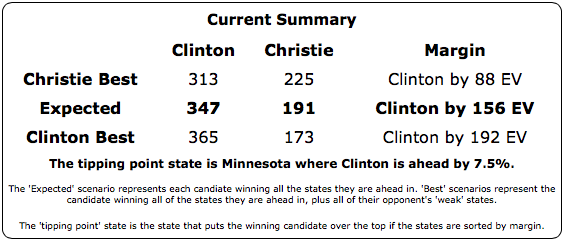
After Christie’s best case peaked at winning by 116 electoral votes back in February 2014, the trend has been downward, and the new change just continues that:

(Once again, click through on the image for… oh, never mind… you get how that works now, right?)
A lot of the “movement” here is still polling catching up with reality, but it does seem like Christie continues to fade, and so far he has not been able to reverse his fortunes. There is of course still a long time until we even get to the Iowa caucuses, let alone the 2016 election, but Christie isn’t doing all that great at the moment.
Since it is Christie’s “best case” that changed with the latest update, lets also take a quick look at the Republican best cases for all of the best polled combinations:

Wow, that looks messy. You’ll note that at the moment none of the five Republicans win against Clinton, even if you give them all of the close states. It looks like Huckabee actually has the best best case, but Huckabee is also the least well polled of the five, so take that one with a grain of salt. Otherwise, in terms of their best cases, in the last six to nine months while Christie’s situation has deteriorated vs Clinton, Bush and Ryan have improved theirs, and Paul has been basically flat.
Of course, Ryan has taken himself out of the race at this point. And Romney seems to have jumped in. As I described last week, as new polls are released Clinton vs Ryan should drop off the “Top 5 Best Polled” list and Clinton vs Romney will probably rise onto it. But not yet. Clinton vs Ryan is still #4 at the moment. The two additional polls for Clinton vs Romney since last week (one in NJ and one in PA) have moved Clinton vs Romney from the 21st best polled combination all the way up to… the 20th best polled combination. Still quite a ways to go. And still very sparse data. But if Romney is serious, the polls will come soon enough.
Stay tuned…
* For the moment, I consider a change to be “worth posting” if it involves one of the five best polled candidate pairs and it either changes one of the “summary” stats (the expected margin, the Republican best case margin, the Democratic best case margin), or there is a change to the tipping point margin of at least 0.1%. Of course, ALL changes in the summary, the tipping point margins, state categorizations, and even individual polls, for all candidate combinations, are posted at @ElecCollPolls for those interested in all those details.
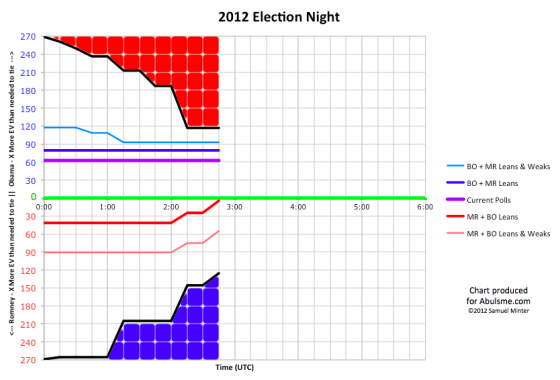
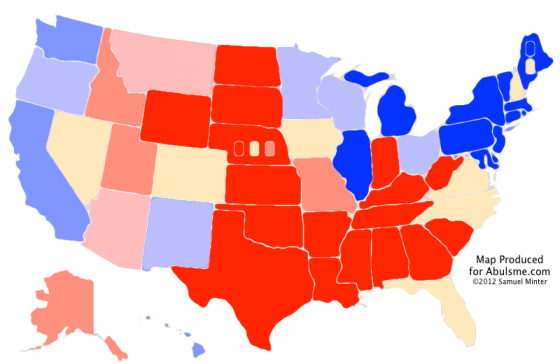
|
Romney |
Obama |
| Romney Best Case |
274 |
264 |
| Current Status |
206 |
332 |
| Obama Best Case |
190 |
348 |
There were no states called between 02:15 UTC and 02:30 UTC, but one big update between 02:30 UTC and 02:45 UTC…
Pennsylvania goes for Obama. This makes Romney’s path to win from the remaining states very very difficult… close to impossible. Let’s look:
With the areas he is ahead by more than 5% in, Romney starts out at 190 electoral votes. Then we have the areas he is ahead in:
- Nebraska 2nd (1): 3.8% Romney lead
- North Carolina (15): 1.4% Romney lead
That gets Romney to 206 electoral votes. Then the remaining close states:
- Iowa (6): 2.0% Obama lead
- Florida (29): 2.3% Obama lead
- Colorado (9): 2.4% Obama lead
- New Hampshire (4): 2.8% Obama lead
- Maine 2nd (1): 2.8% Obama lead
- Virginia (13): 3.6% Obama lead
- Nevada (6): 4.8% Obama lead
If Romney wins ALL of those states, he gets to a 274 to 264 win over Obama. He has 5 electoral votes to spare. He can afford to lose New Hampshire and Maine’s 2nd, which would give him a 269-269 tie, which would probably result in a Romney/Biden administration. But he can’t afford to lose ANY of the other remaining states.
The tipping point is now Nevada. Obama was ahead by 4.8% in my five poll average in Nevada.
This is almost over. Romney sweeping all of those states is basically inconceivable.
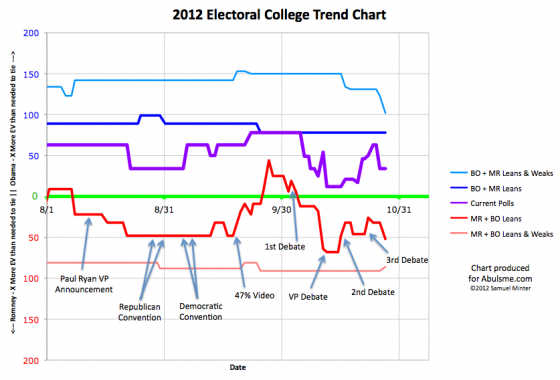
Four states change status today, three moving toward Romney, one moving toward Obama. On the surface this looks very good for Romney. We’ll look into why that might not be the case in a bit, but first lets look at the four states that move today:
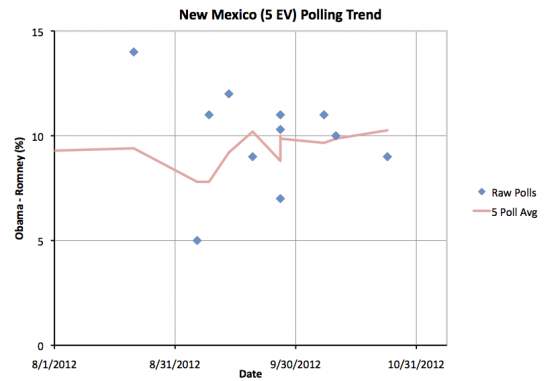
Very little to say about New Mexico. Obama’s lead increases slightly and is now over 10%. Obama will win New Mexico.
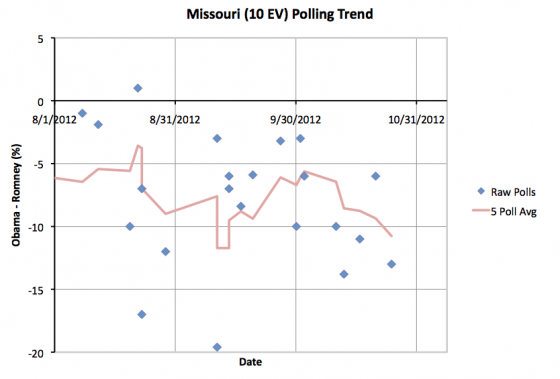
Not much to see in Missouri either. Romney’s lead increases slightly and is now over 10%. Romney will win Missouri.
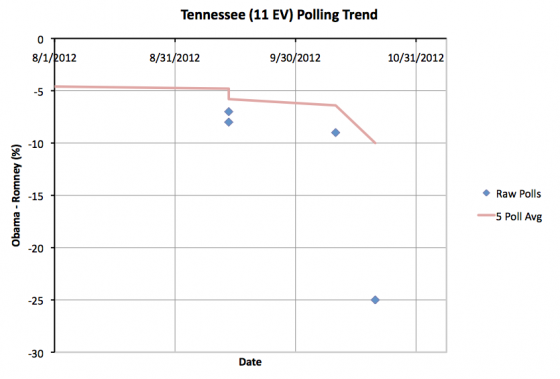
Tennessee is a bit odder. The new poll showing a 25% Romney lead in Tennessee looks like an outlier. No other poll in the state from the last year shows a Romney lead greater than 9%. Without this poll the five poll average has a Romney lead of 6.4%. With this, the Romney lead jumps to 10.0%, which moves Tennessee to the “Strong Romney” category. This may not be deserved, but I don’t make judgements about outliers, I just let the average sort it out. Either way, Tennessee’s not in contention this year. Romney will win Tennessee.
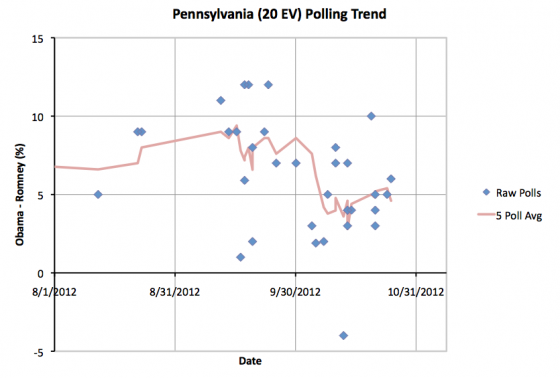
Pennsylvania shows Obama’s lead dropping under 5% again as an outlier showing Obama leading by 10% drops off. Again, we just let the average deal with outliers here, and that is what has happened. Pennsylvania returns to “Lean Obama” which probably better represents the true state of the race in Pennsylvania at the moment. Having said that, it is at the high end, Obama’s lead in the five poll average is now 4.6%. This is a pretty substantial lead. Any scenario that has Romney winning Pennsylvania would already have him wining the presidency handily.
OK, so this gives us this new map and summary:
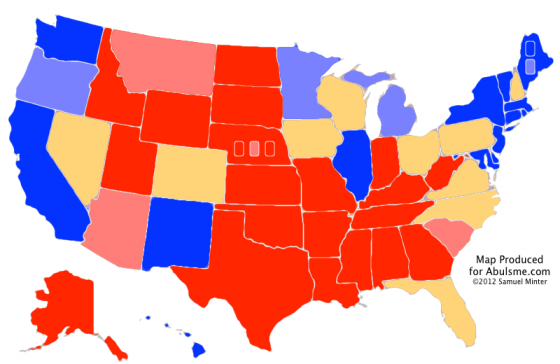
|
Romney |
Obama |
| Romney Best Case |
321 |
217 |
| Current Status |
235 |
303 |
| Obama Best Case |
191 |
347 |
As before though, since depending which way the close states go you could have either candidate winning, we need to look at the individual states:
- North Carolina (15 ev): 2.4% Romney lead – 4/5 polls after last debate
- Florida (29 ev): 0.8% Romney lead – 5/5 polls after last debate
- Virginia (13 ev): TIE – 5/5 polls after last debate
- Iowa (6 ev): 1.2% Obama lead – 2/5 polls after last debate
- New Hampshire (4 ev): 2.2% Obama lead – 2/5 polls after last debate
- Colorado (9 ev): 2.8% Obama lead – 5/5 polls after last debate
- Nevada (6 ev): 2.8% Obama lead – 5/5 polls after last debate
- Ohio (18 ev): 3.1% Obama lead – 5/5 polls after last debate
- Wisconsin (10 ev): 3.8% Obama lead – 3/5 polls after last debate
- Pennsylvania (20 ev): 4.6% Obama lead – 2/5 polls after last debate
Something interesting here, but I am running out of time to go into detail. Ohio is no longer the tipping point state! If you start adding these states up in order of how far away they are from Romney, you see that Romney’s clearest path to victory is now holding North Carolina and Florida, then pulling ahead and winning Virginia, Iowa, New Hampshire, Colorado and Nevada. If he does that, he wins 273 to 265.
So as of today, if he moves every state more than 2.8% toward him, Romney wins. But yesterday that percentage was 2.5%. Wednesday it was 1.6%. Tuesday it was 1.2%
I may make a spiffy graph of this with the next update, but for now just looking at those numbers, you can see that despite moving some states closer to him, Romney’s path to victory is slipping away. The states he needs to pull ahead in are instead slowly pulling away.
Note: Chart and map from the Abulsme.com 2012 Electoral College Prediction page. Both assume Obama vs Romney with no strong third party candidate and show polling as it currently exists. Things will change before election day. On the map red is Romney, blue is Obama, gold states are too close to call. Lines on the chart represent how many more electoral votes a candidate would have than is needed to tie under several different scenarios. Up is good for Obama, Down is good for Romney.
|
|

























































